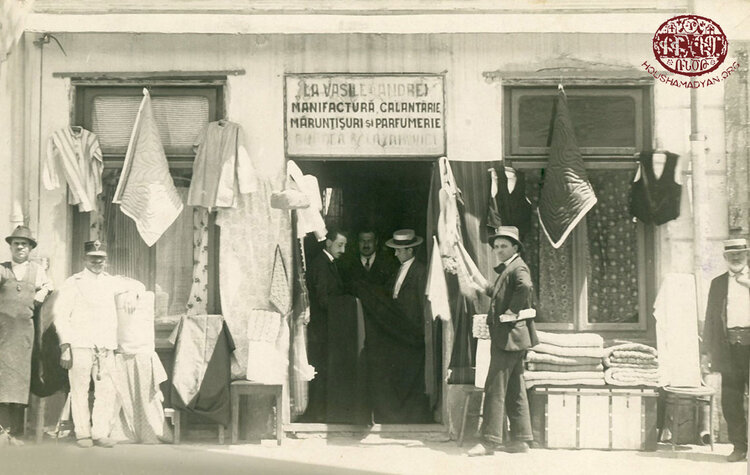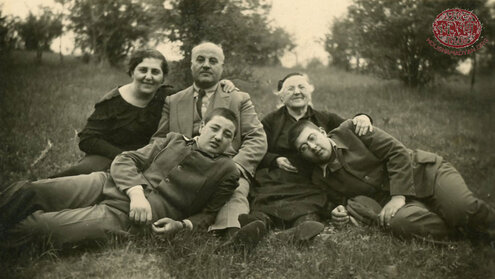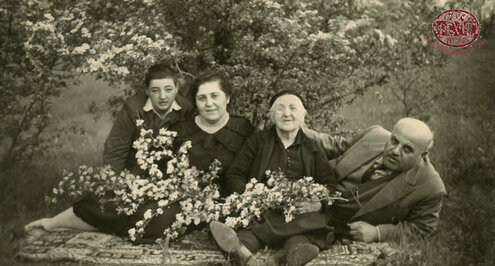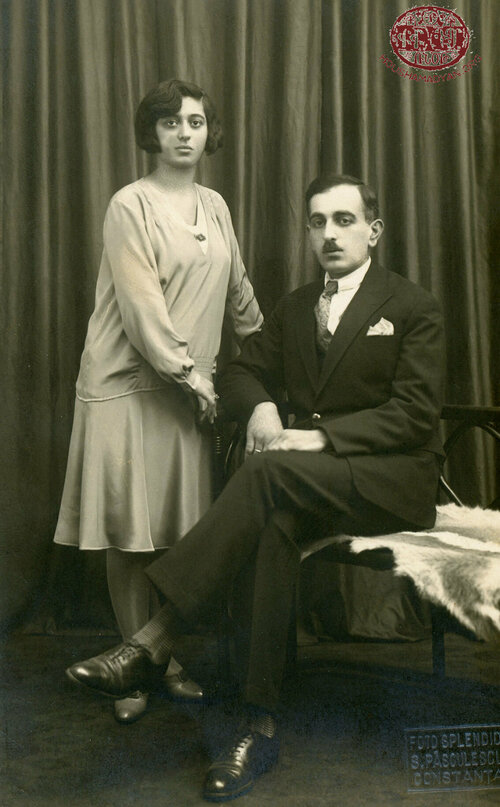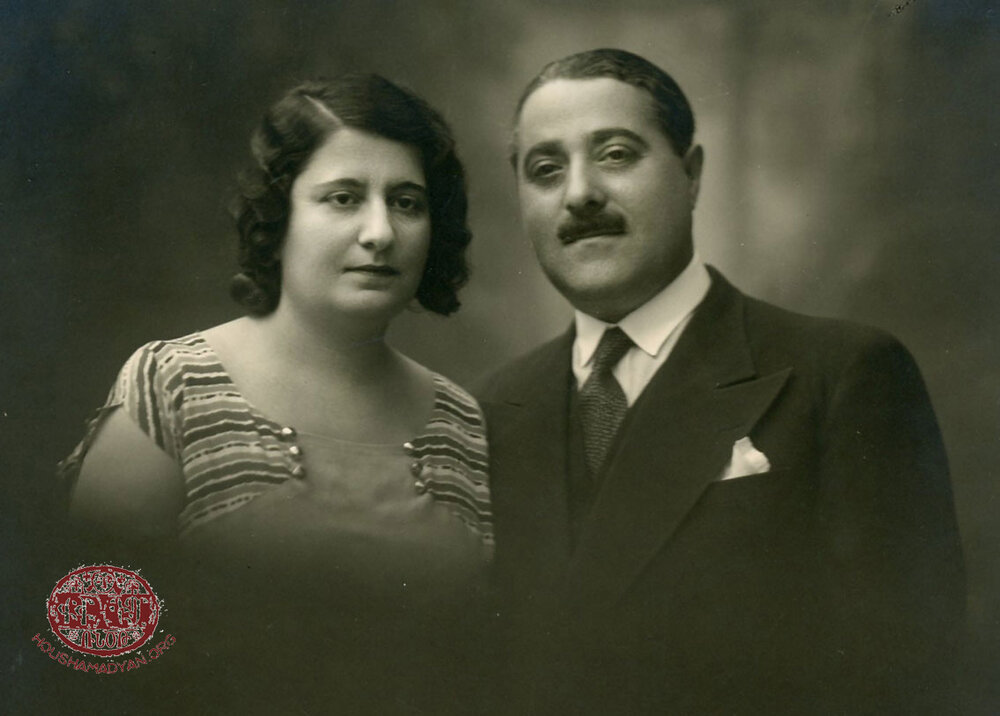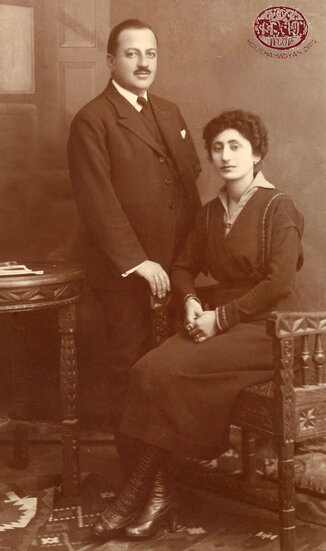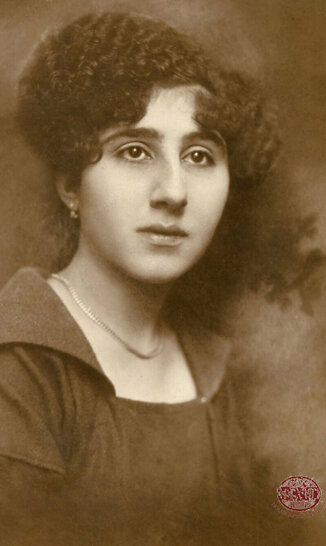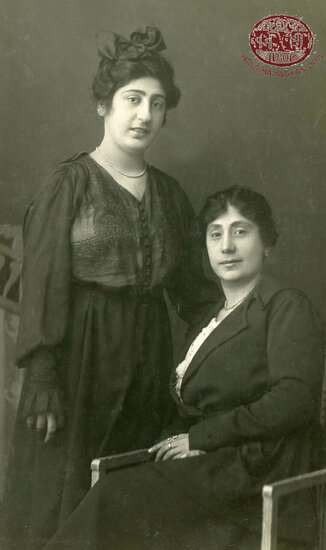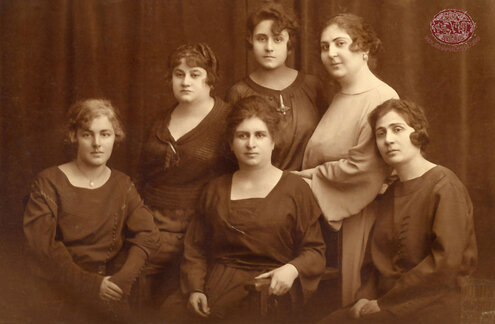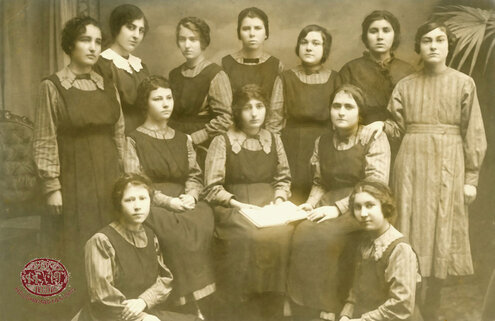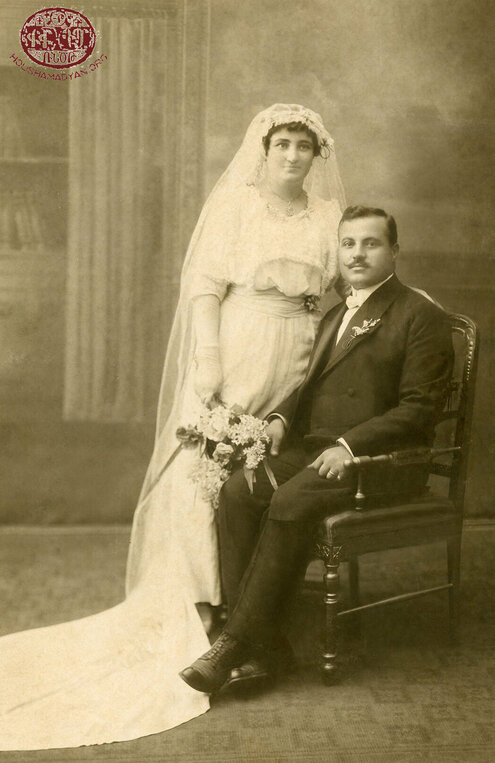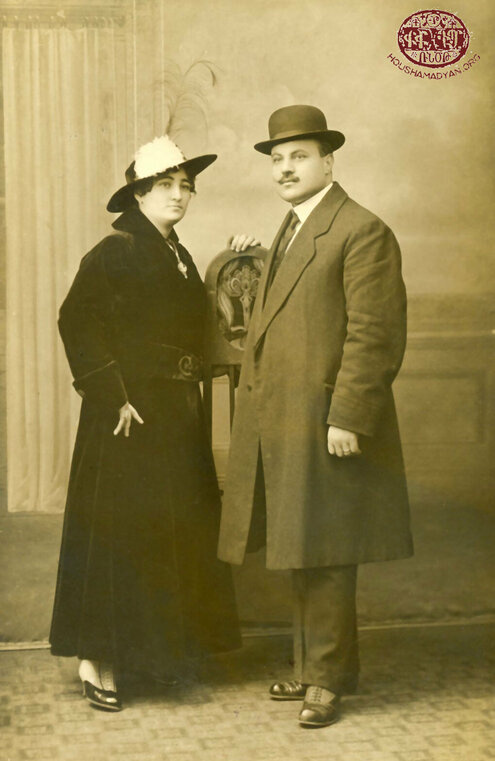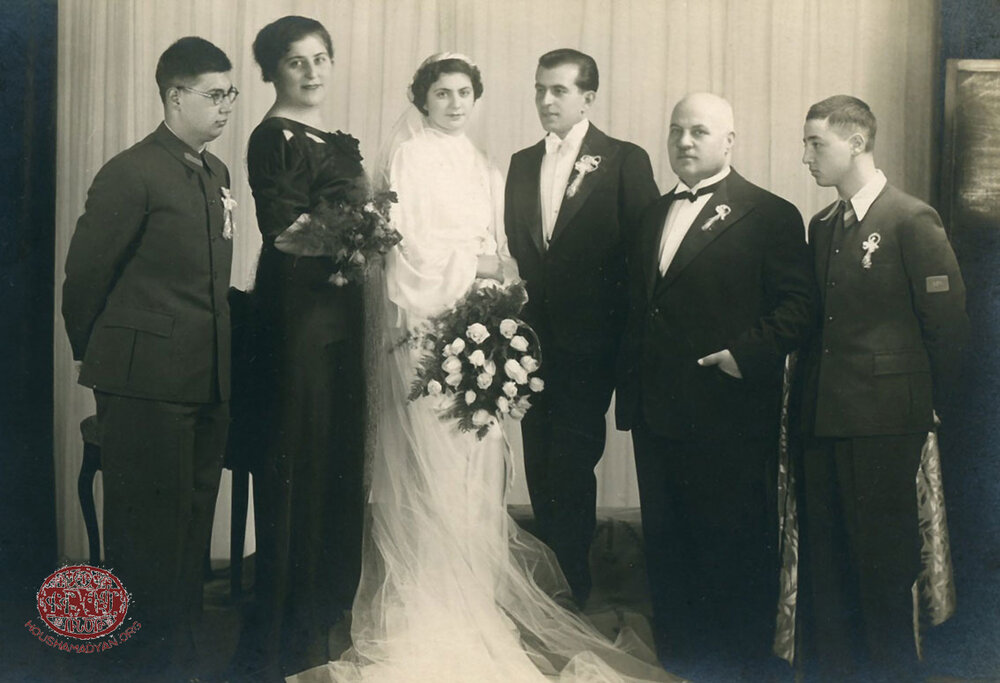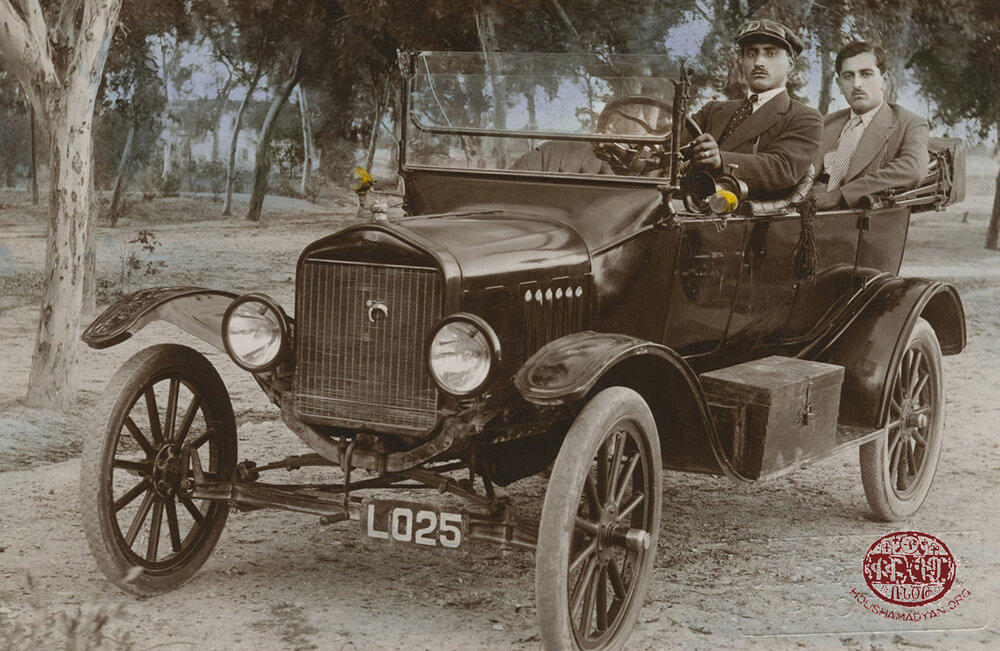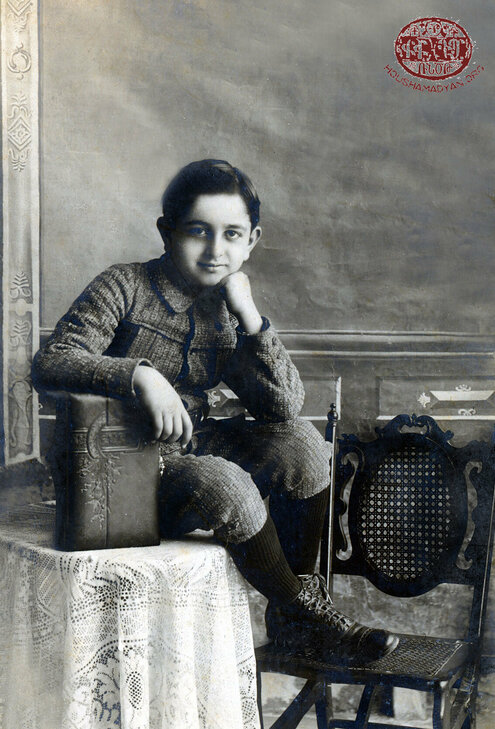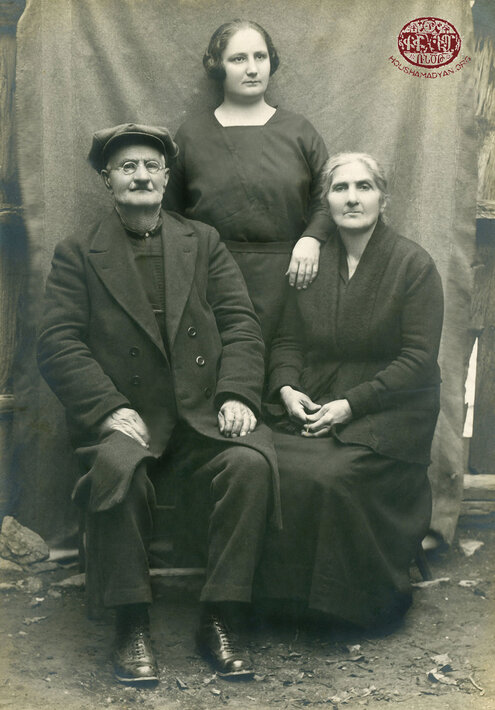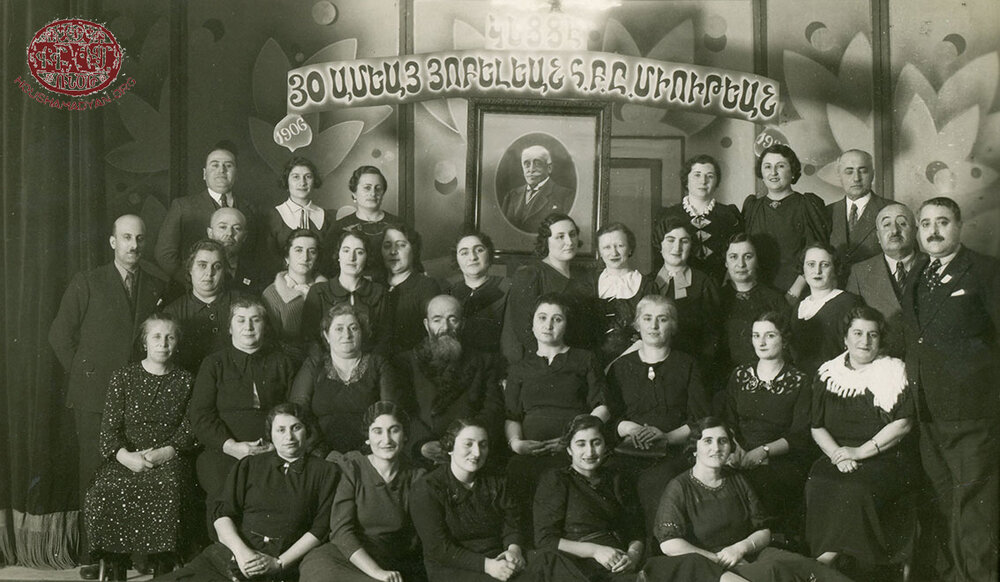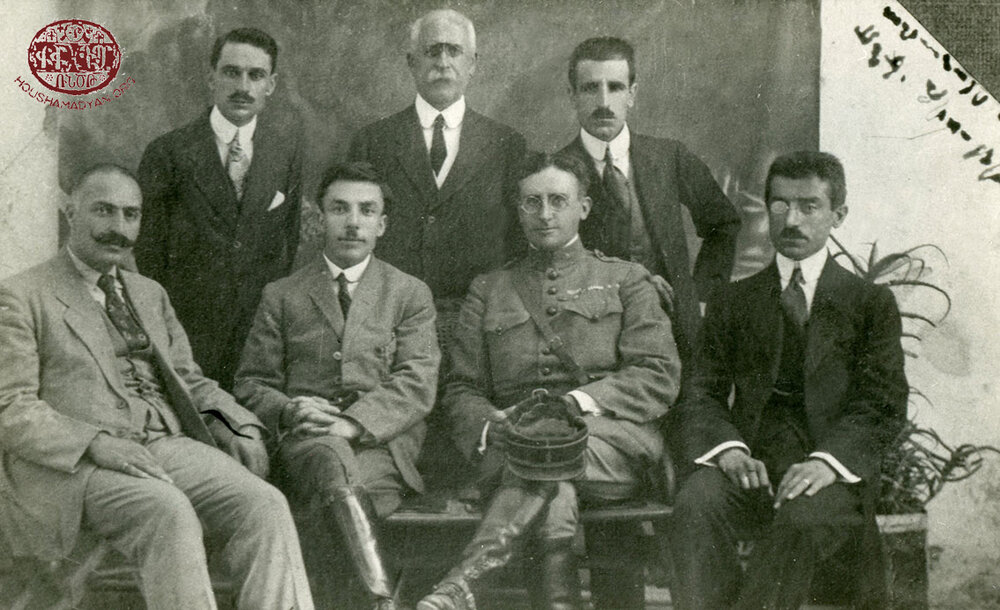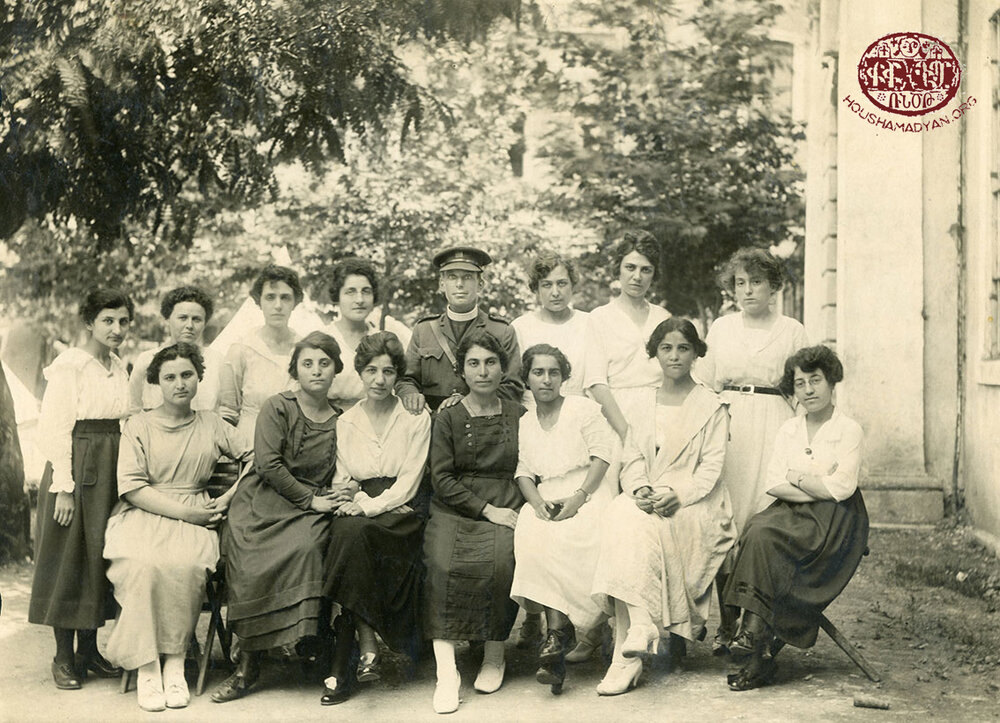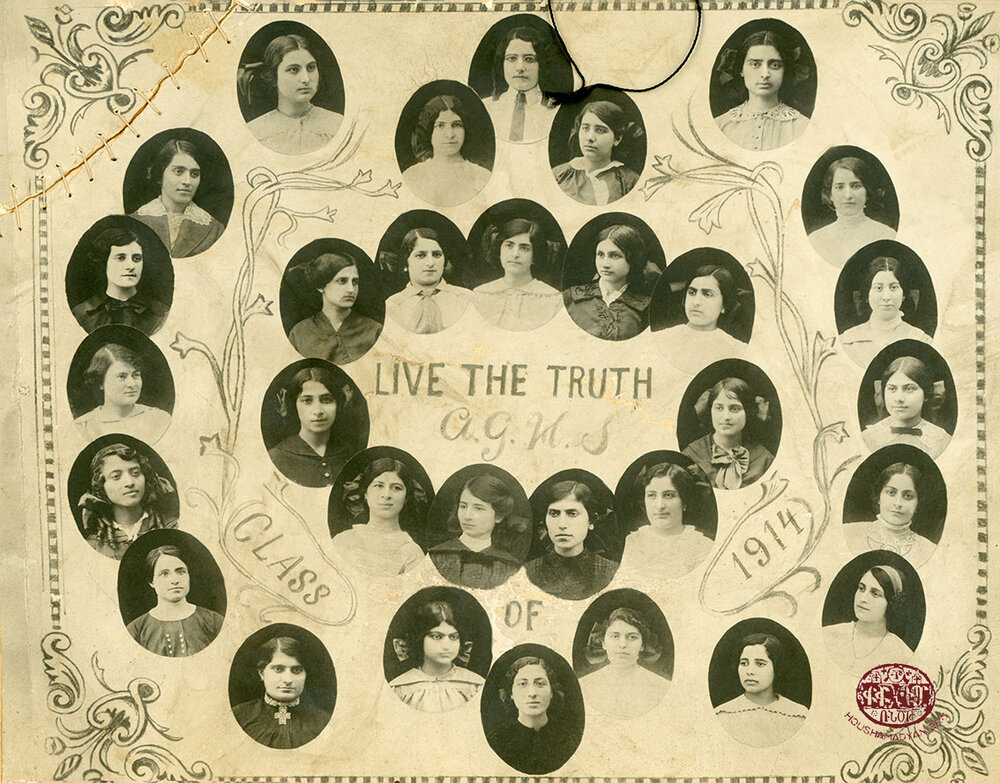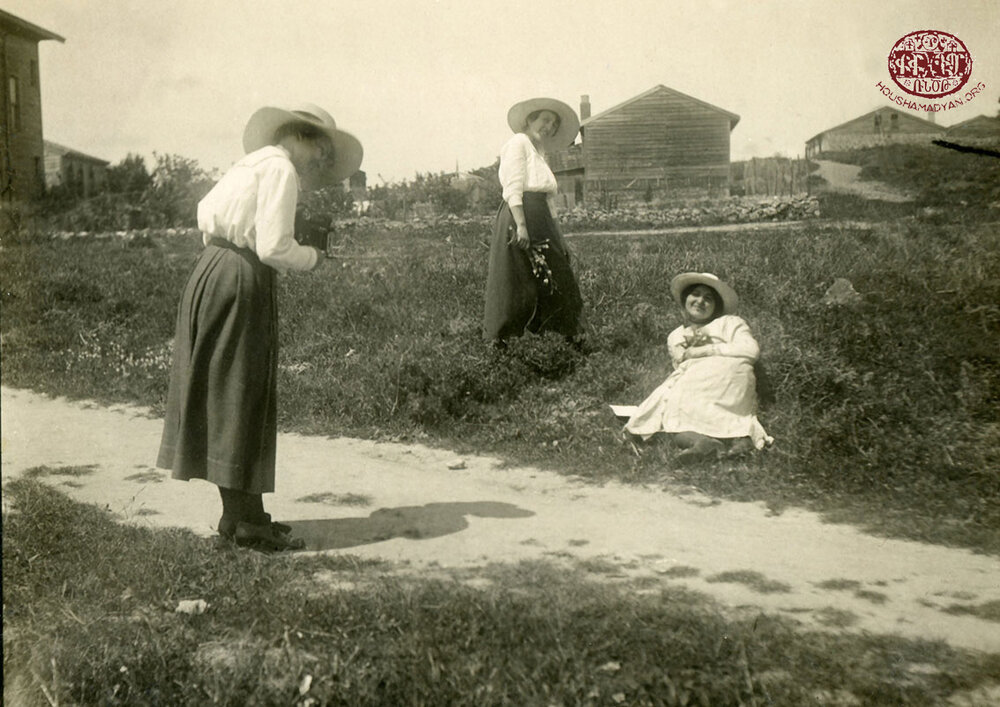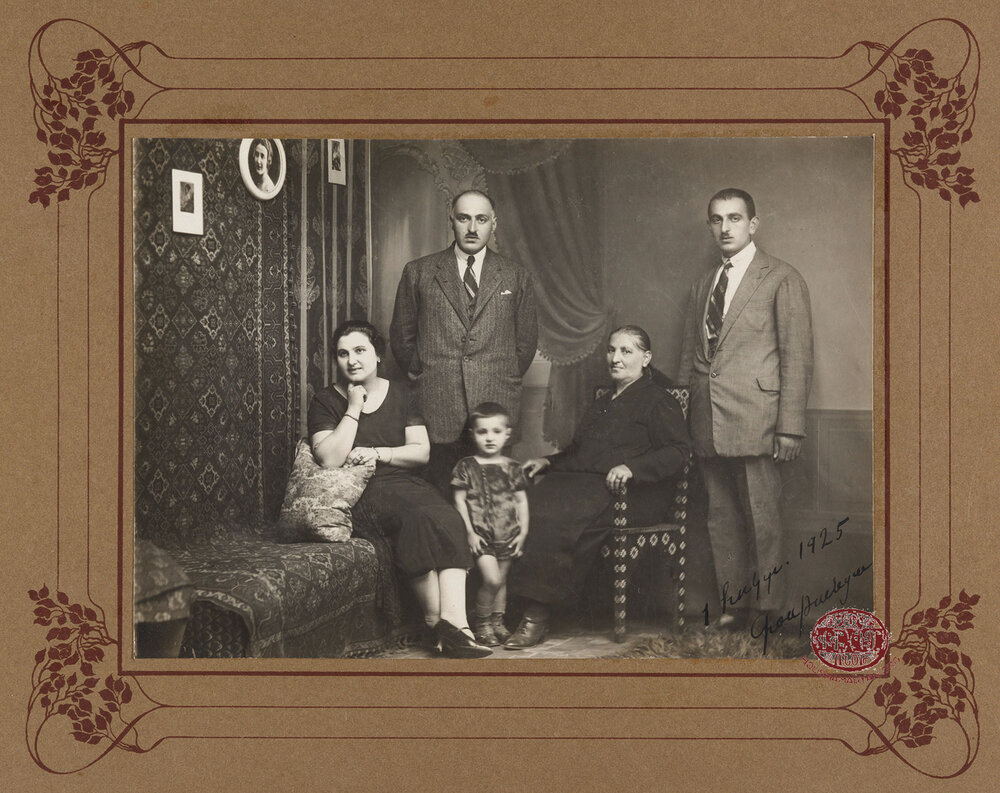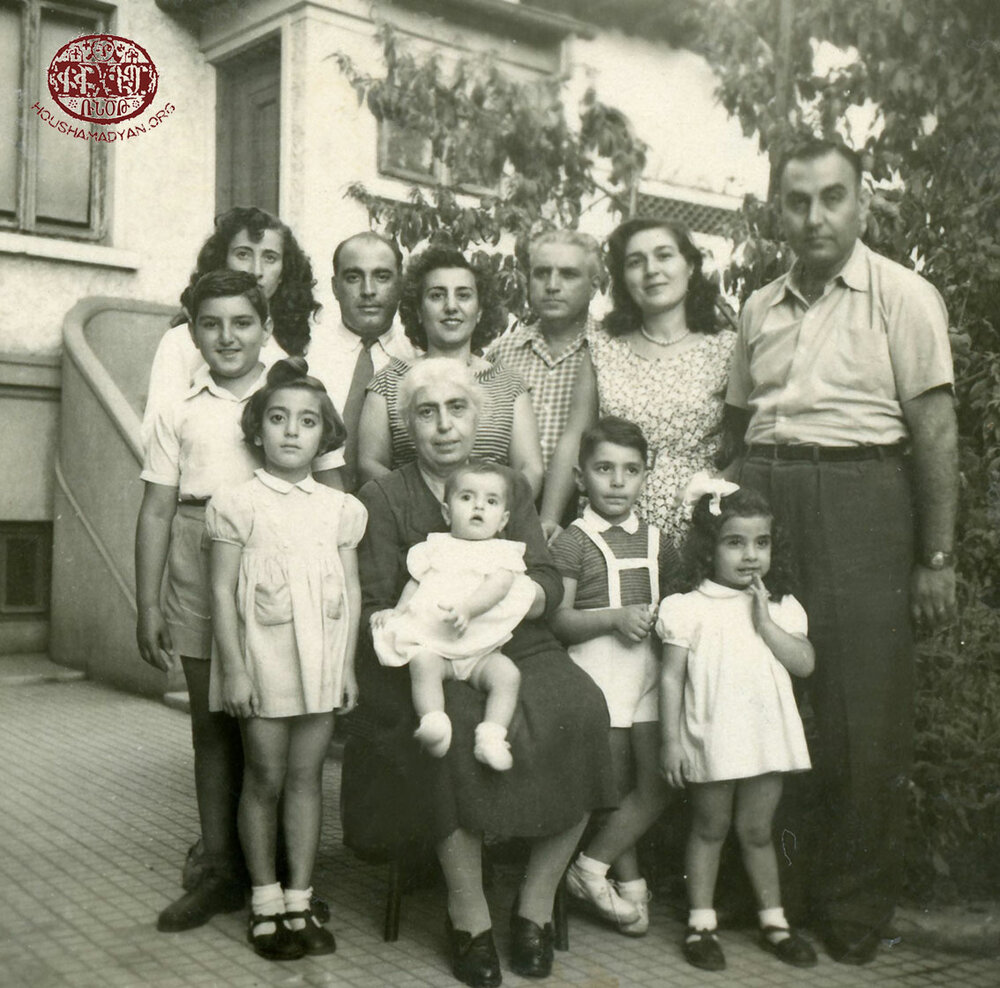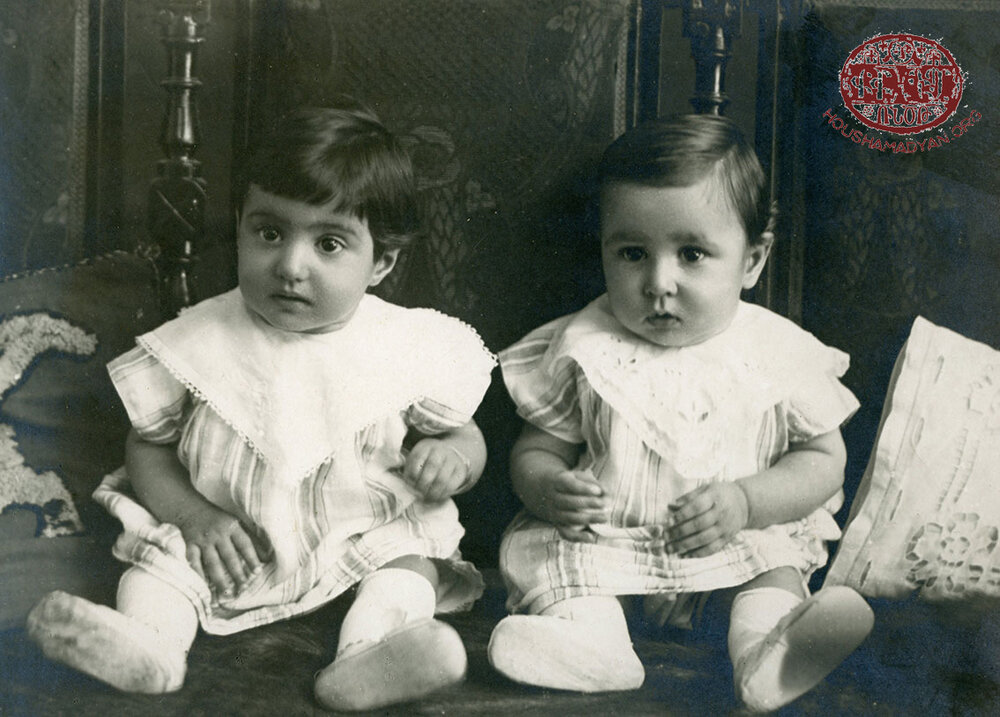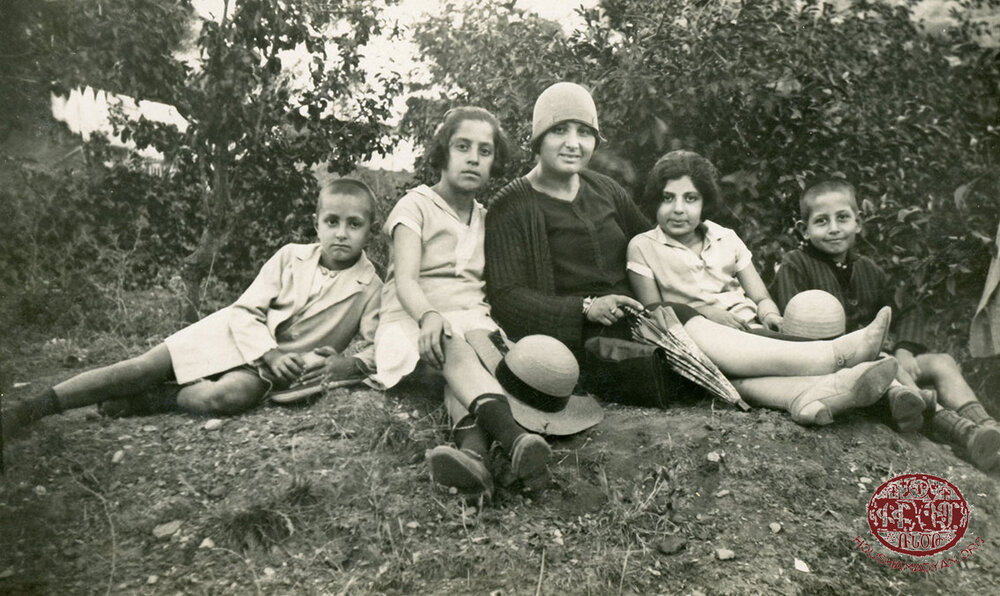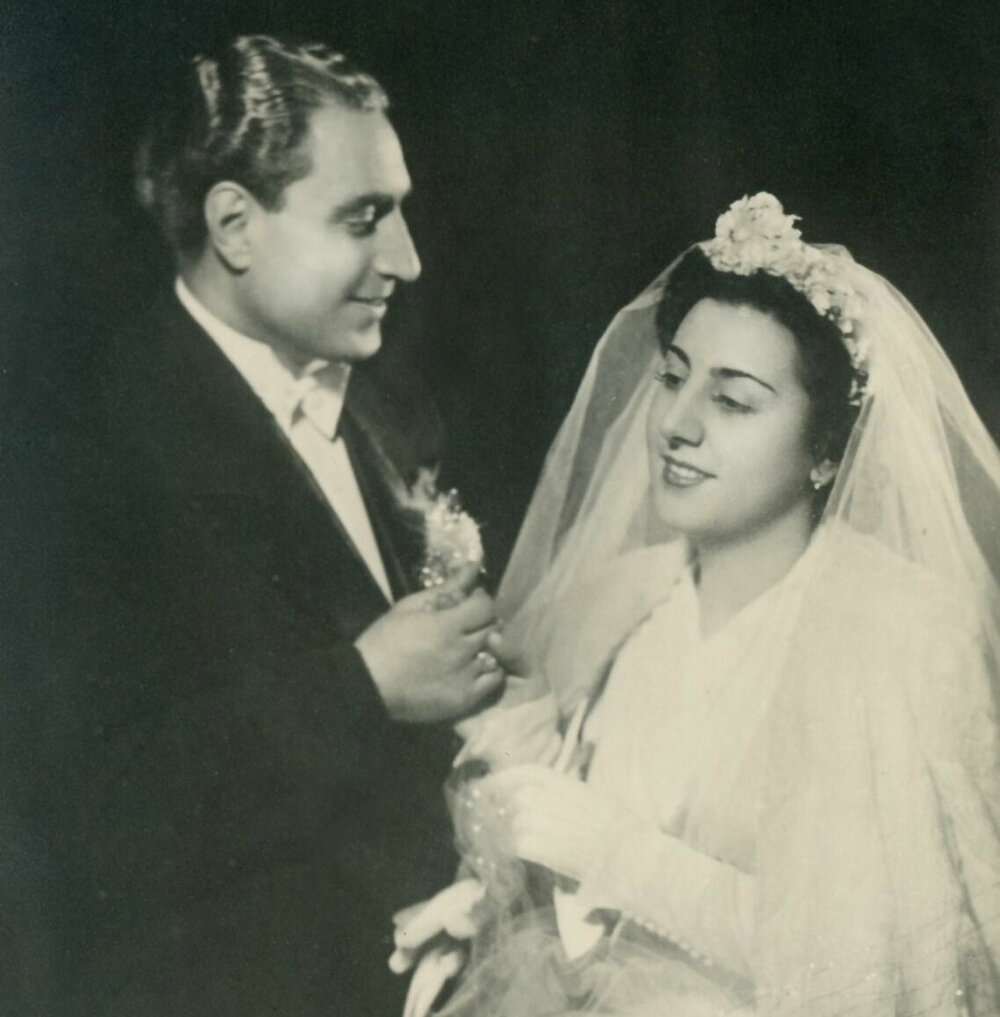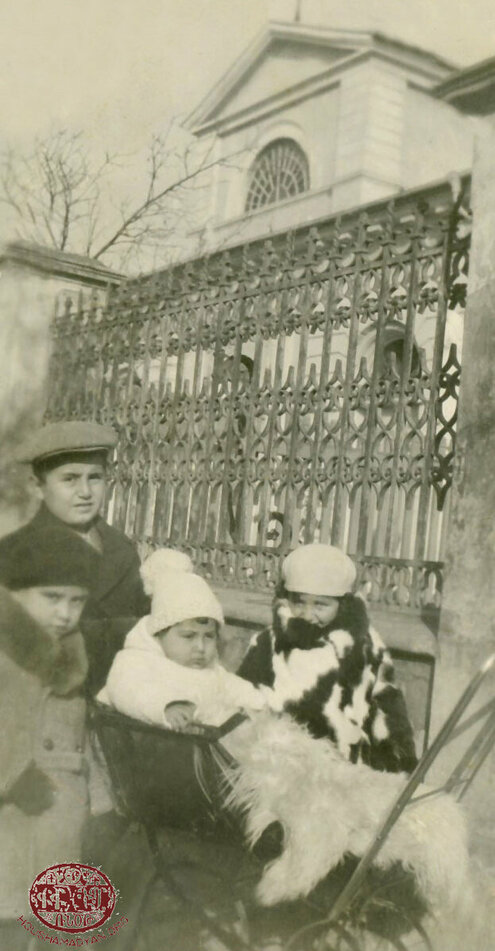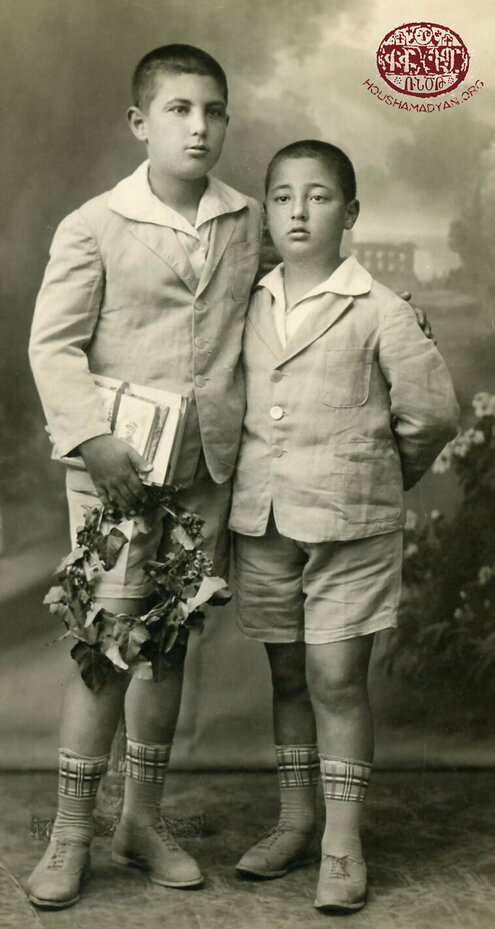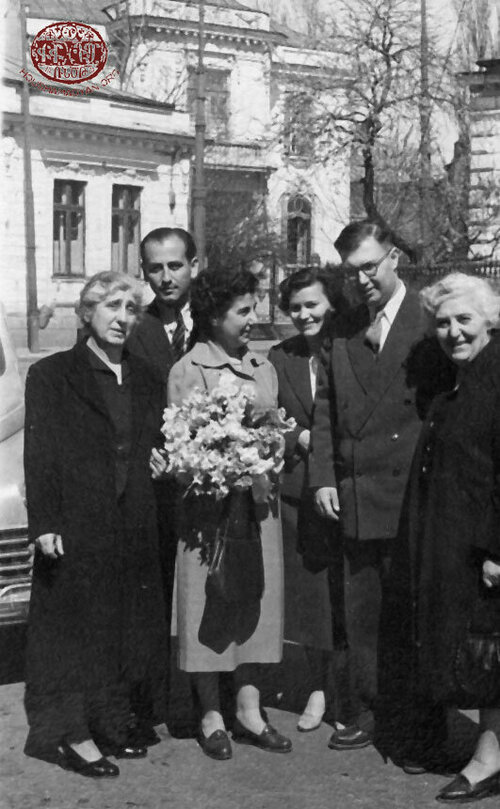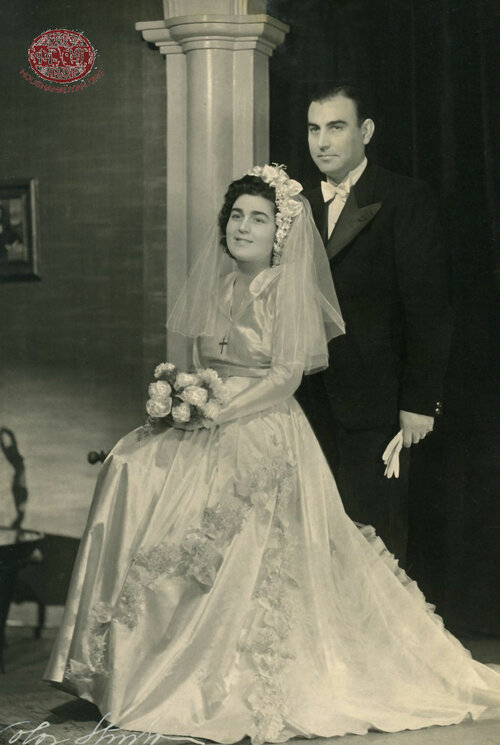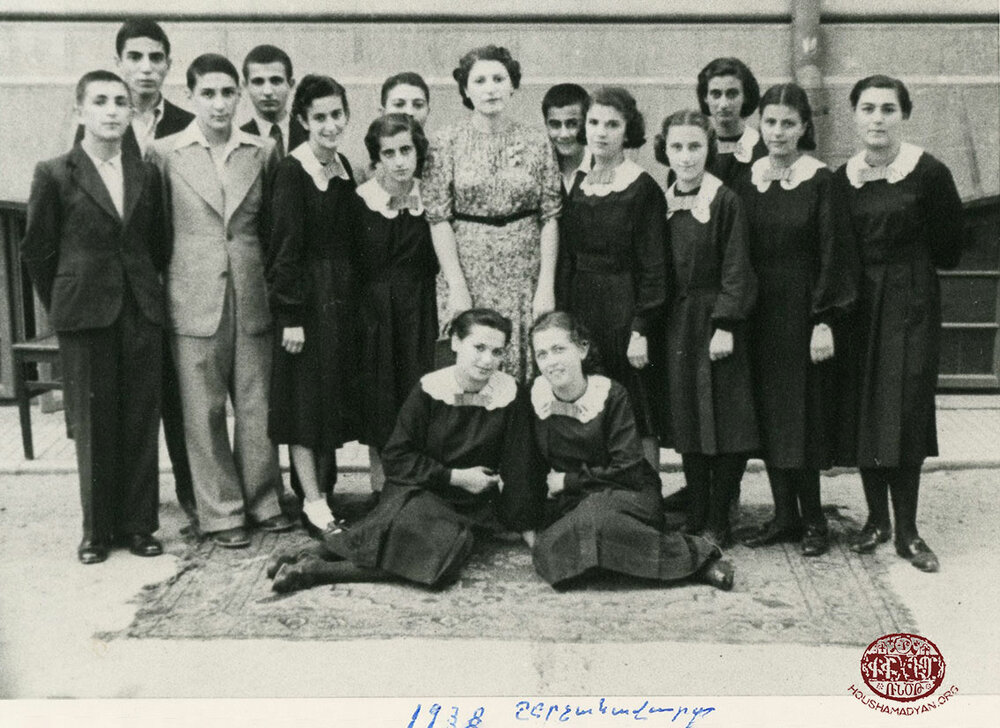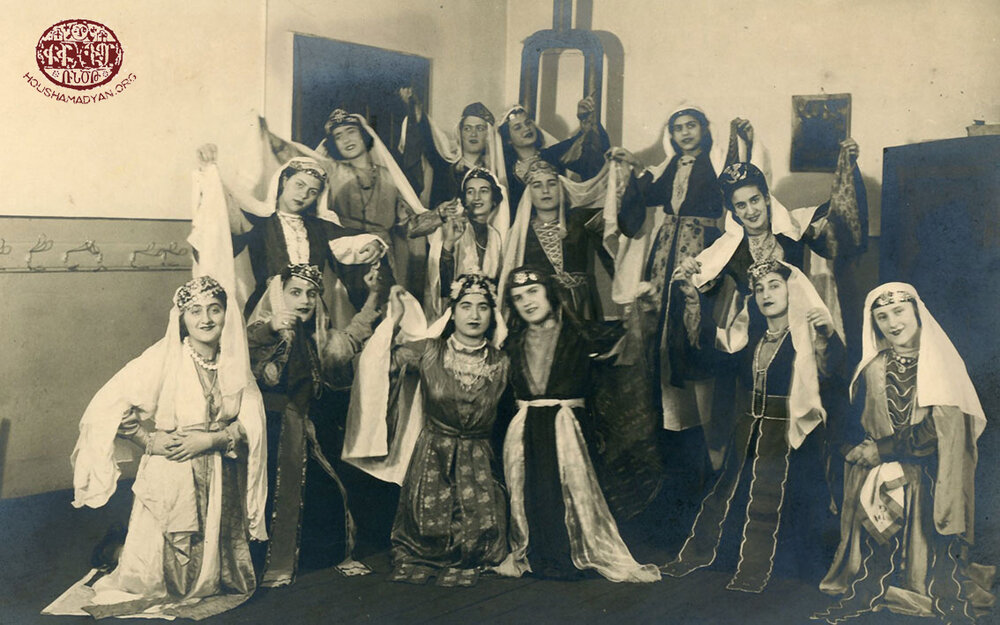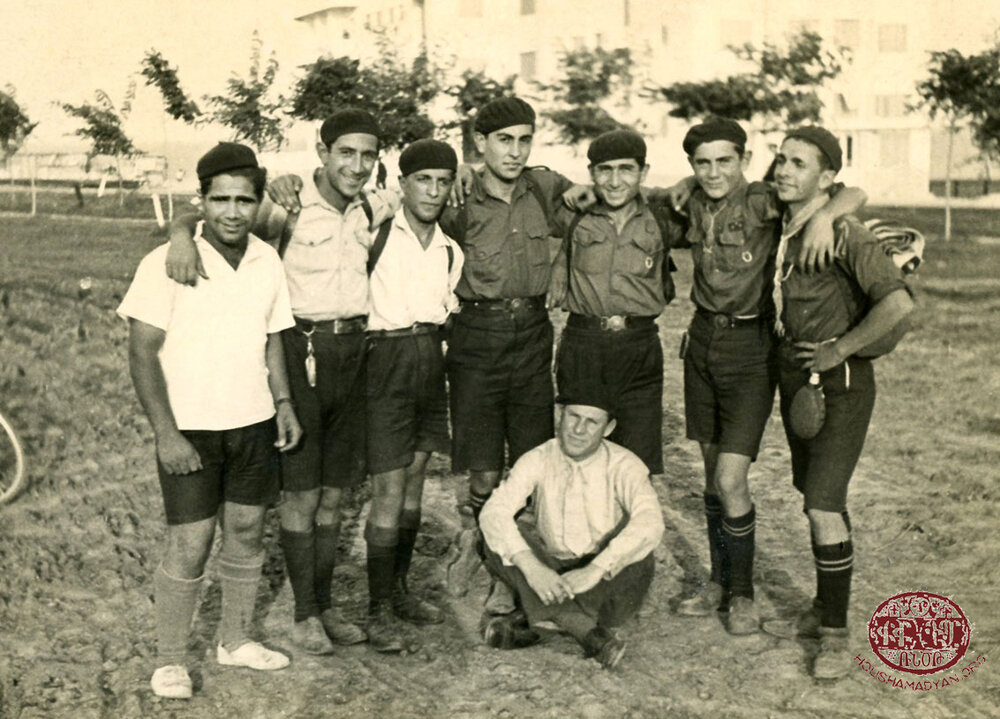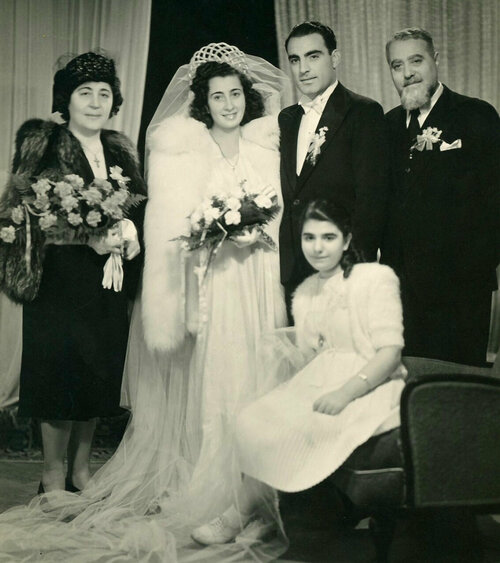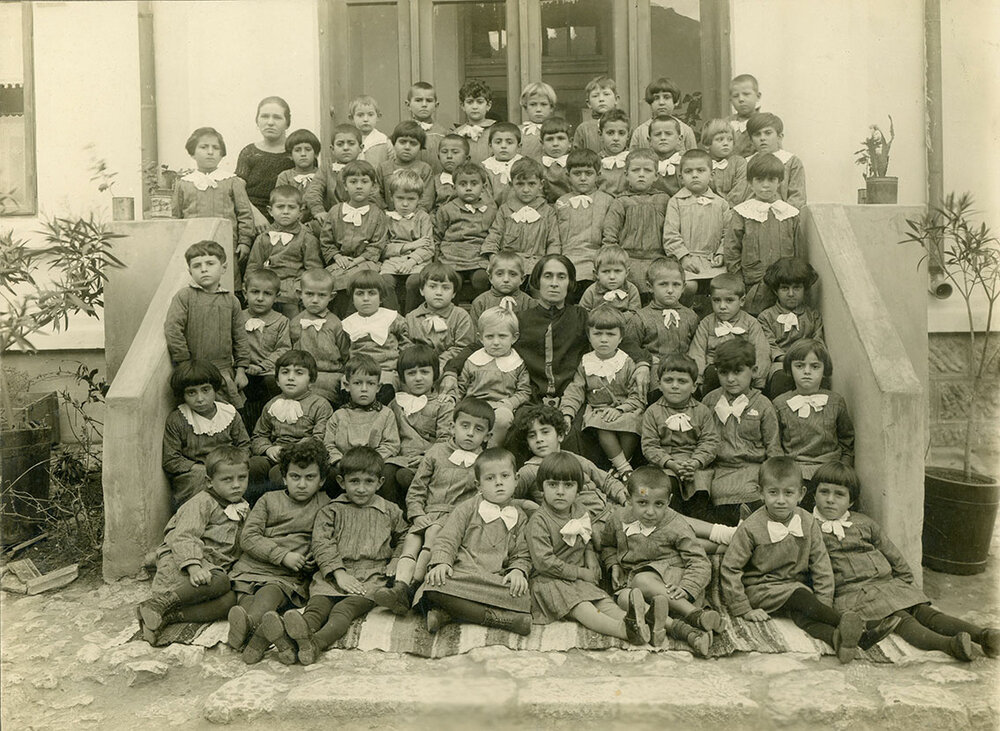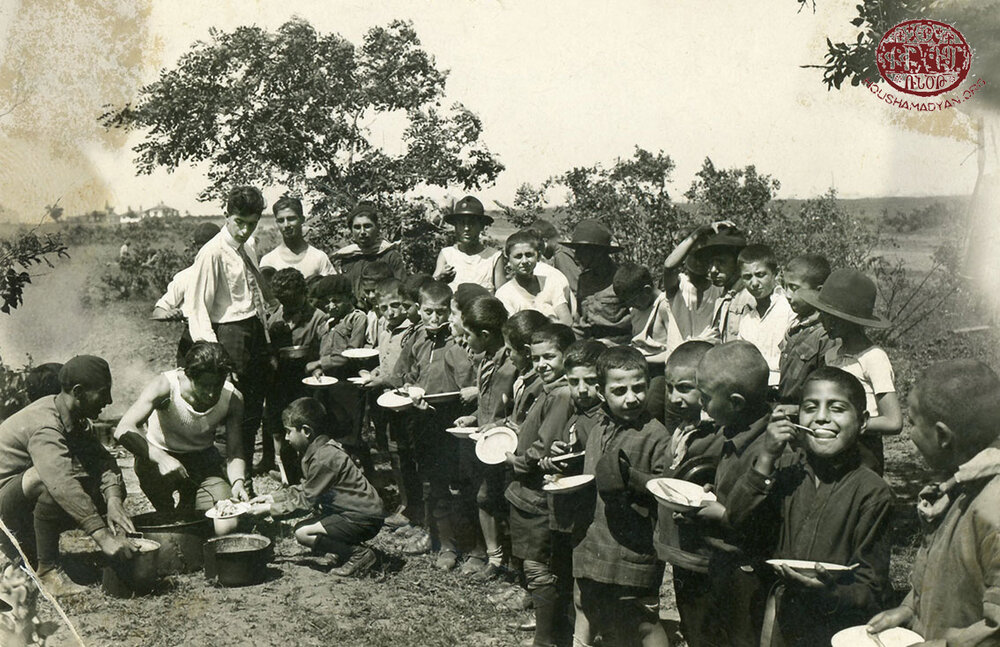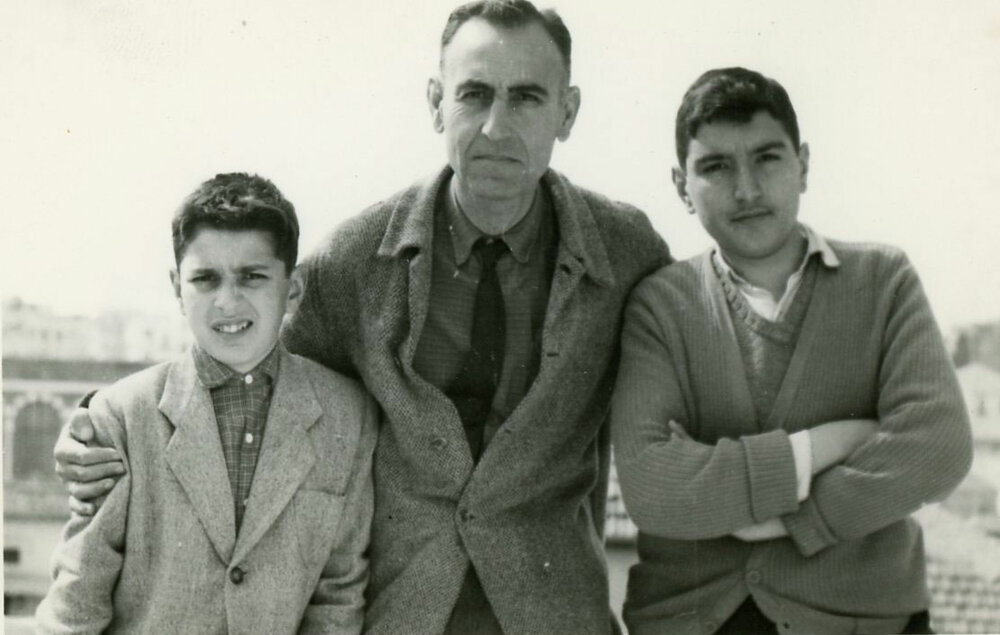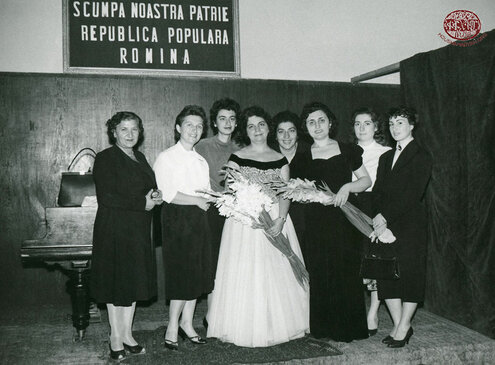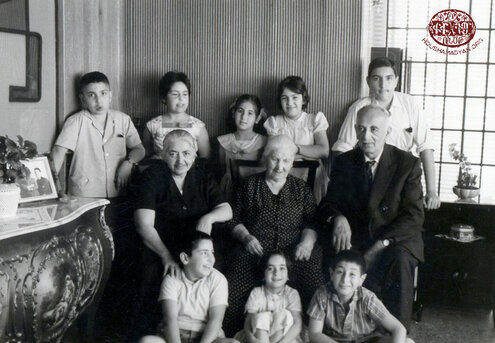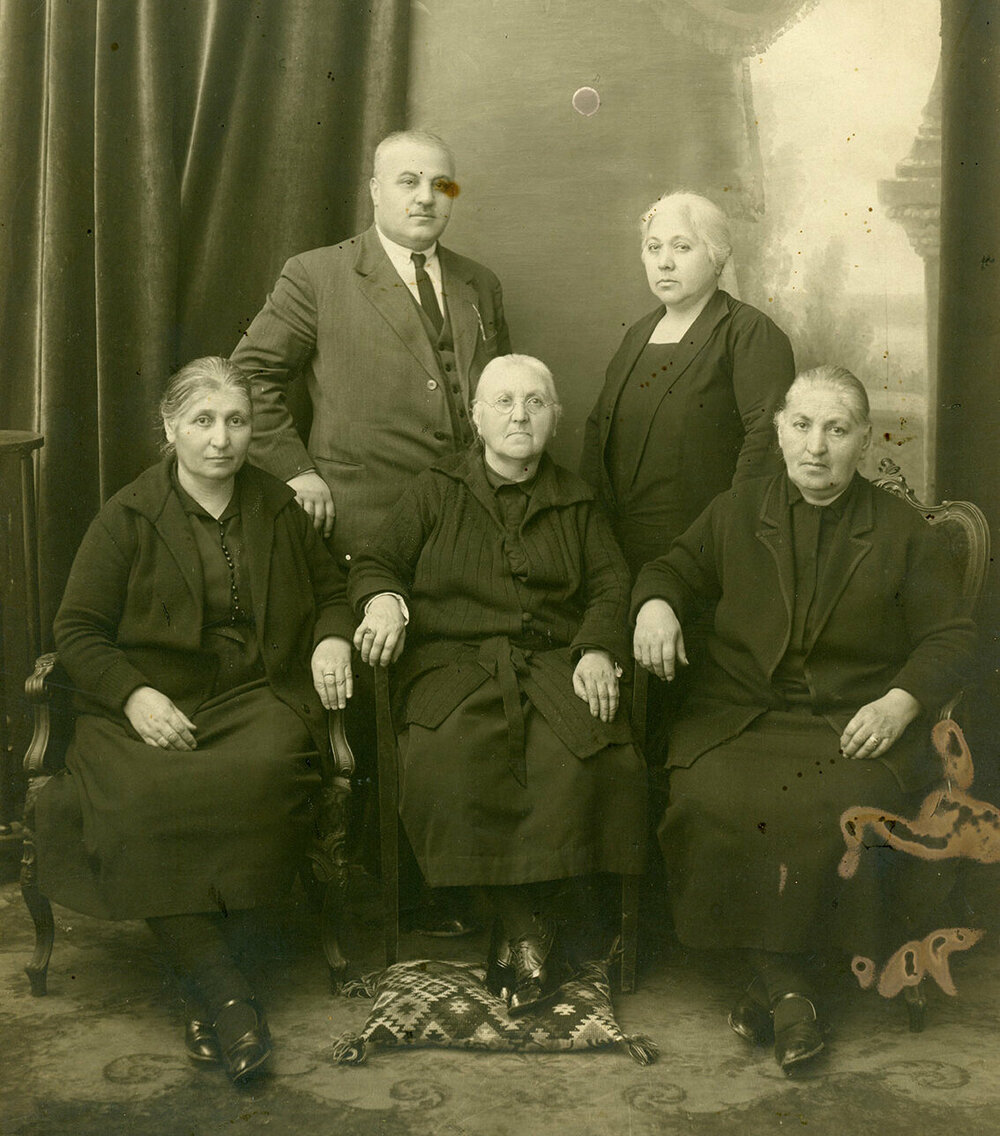Ashekian/Iynedjian/Bakalian/Bohdjelian Part IV
POST III: The Descendants of Parsegh Ashekian from Kayseri/Gesaria who settled in Romania until after World War II
Author: Anny Bakalian, New York, 25/03/2022 (Last modified 25/03/2022)

Parsegh Uzun Ashekian, the patriarch of the Ashekians settled in the Ottoman Empire, Kayseri/Gesaria at the turn of the 19th Century. His descendants multiplied and prospered. During World War I, the Genocide expelled Armenians from their ancestral lands and homes, sent them to the desert and starved them to death. The Ashekian Clan from Kayseri was lucky; their members supported each other financially. The Ottoman Empire Army commanded the Ashekian-Bakalian flourmill in Adana, and the Armenian men who were in Cilicia became employees of the flourmill, thus they were not deported.
This is the story of those who moved to Romania from about 1894 to the 1960s. Avedis Antreas Bohdjelian left the Ottoman Empire in 1896 and settled in Romania. He established commercial enterprises in Constanța and Galați where he built his factory. He was the great-great grandson of the patriarch (Fourth Generation). The Kingdom of Romania was the first state to give political asylum to Armenians after the Genocide. Then his brother, Armenag Antreas Bohdjelian, followed him, and by 1920, the Allahverdian, Ayanian, Ashekian, Iynedjian and Suzmeyan families lived mostly in Constanța and Bucharest. By 1940, the numbers of Armenians in Romania were estimated to number from 40,000 to 70,000.
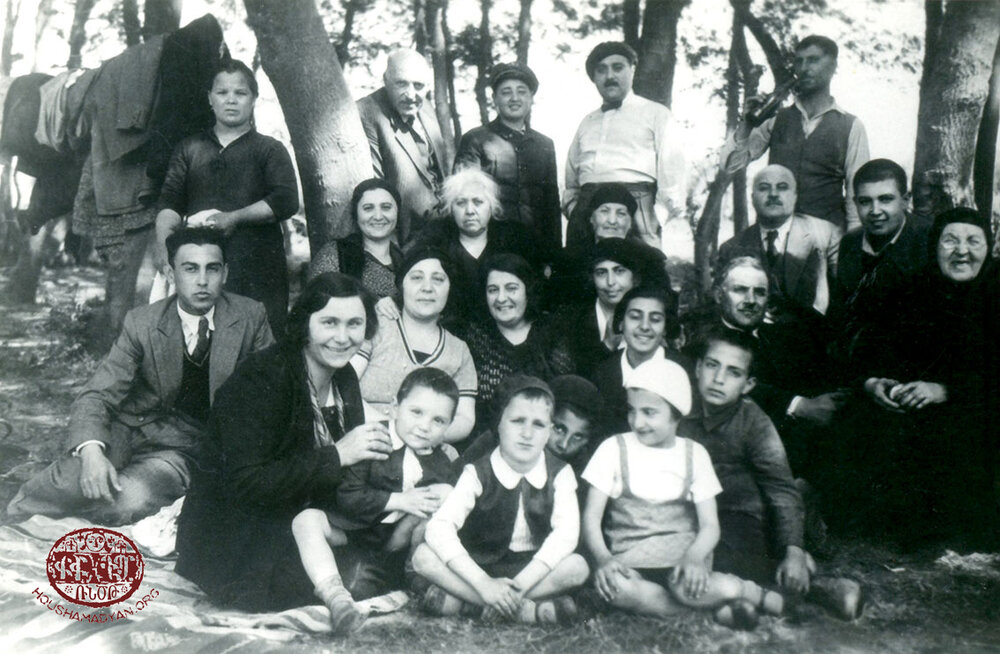
After World War II, the Soviets encouraged Armenians in the diaspora to repatriate, Nerkaght, simply to “go home.” More than 100,000 men, women and children went to Armenia SSR. Garabed Ashekian confirms in his book that Harutiun (Artin) Allahverdian and his family moved to Yerevan in 1947 (see also POST I on the Nerkaght).
The Soviets interfered forcefully in Romania in spring 1945 and pushed King Michael to appoint a pro-communist to form the government of Romania. Without any alternative, the King abdicated on December 30, 1947 and Romania became a satellite of the Soviet Union.
The centralized system of the Party Congress made the lives of the citizens miserable. Consumer goods, including food, clothing, shoes and housing, were not produced sufficiently and were not distributed equally. Further, personal property such as houses, shops and factories were confiscated; some persons accused of hiding gold or acting bourgeois were sentenced to prison. Between 1951 and 1965, the American National Committee to Aid Homeless Armenians (ANCHA) [1] through their representative, Hovanes Chakerian, in Beirut helped the members of the Clan from Kayseri to process their visas for the U.S.A. They finally settled in the United States with a few settlings in Canada.
George Mardikian [2] and Suren Saroyan [3] established the American National Committee to Aid Homeless Armenians (ANCHA) in 1947 to aid Displaced Persons (DP) in Europe after World War II. ANCHA opened over 60 offices and mobilized about 300 to 400 Armenian volunteers across the U.S.A. The goal was to raise funds, lobby the United States government, send food and clothes and provide shelter to compatriots in distress. ANCHA helped over 3,500 Armenians DPs by 1952, when the Displaced Persons Act expired. The legal skills of Suren Saroyan were critical at ANCHA to the sponsoring and aiding of migration to the U.S.A. through the 1953 Refugee Relief Act. [4] According to Hratch Zadoian in his book on ANCHA, “Romania and Bulgaria were among the most oppressive of the communist regimes. For those wishing to leave, exit visas were practically impossible to obtain.” [5]
There are often exceptions, Garabed Ashekian and his family left from Constanța and arrived in Beirut in June 1951 because his nephews (the Bakalians) procured them Lebanese passports. And Haigazun Suzmeyan and his wife Marie (née Hovhannes Iynedjian) and their three sons went to Beirut in 1951 because Haigazun was a citizen of Iran.
After the Hungarian Revolution and Polish Thaw in October 1956, “there was a gradual, grudging ‘liberation’ of travel restrictions, benefiting the majority of the Armenians and Jewish communities.” [6] Armenians were allowed to request exit visas for “family reunification” in Lebanon. Nonetheless, Armenian émigrés’ final months and days in Romania were difficult through the bureaucracy and the demand that they “gift” their homes “cleaned, painted and in good repair” [7] to the government. Each member of the family was allowed 75 kilos of baggage, but not gold or valuables. The Romanian officials required an exit visa (Certificat de Calatorie). Relatives in Beirut or those who arrived before would give a handler U.S. $100 for one person and $200 to $300 for a family for the Lebanese visa. The French Embassy in Bucharest represented the Lebanese Republic’s interests. [8] The Allahverdian, Ashekian, Ayanian, Bohdjelian, Djirikian and Suzmeyan families went to Beirut by boat. [9] They were among the 3500 Armenians who left Romania. [10]
When Garabed Ashekian and his family arrived in Beirut in 1951, his nephews rented them an apartment in the Mar Mikael district across the Saint Michel Maronite Church, near Bourj Hammoud. After their son and daughter left for Canada, Garabed and Berjouhi, joined them in early 1959. Few months later, his brother Hagop Ashekian arrived in Beirut with his wife, son and his brother-in-law, Vahram Iynedjian. The Bakalians who had moved to Badaro, a new suburb, left their Khandaq el-Ghamiq home for their relatives. Traveling with them was Hripsimé (née Taniel Allahverdian) Ayanian, her elder son Garabed and wife and son, and her daughter Hermine Djirikian with her husband and son. All together 11 persons of three generations lived in one apartment. Other families, related to the Ashekians, rented apartments and searched for work until their papers for the U.S.A. were ready. Like the families of Ashekian Clan from Kayseri, Hratch Zadoian says, “Many families represented two or three generations: older parents, most often Genocide survivors who had fled from Turkey, the younger generation, educated and employed in Romania, and in many cases, their children.” [11]
In 1953, a Refugee Relief Act allowed only “refugees who fled illegally at great risk” [12] to immigrate to the United States. The staff of the United States of America Embassy in Beirut required Armenians for interrogation periodically to confirm that they were persecuted in Romania, politically, economically and socially. Later when the U.S.A. immigration law changed in 1965, the procedure was much easier. Suren Saroyan visited Beirut in 1957, returning often to expedite his mission. Traveling from Beirut by plane to New York City or other cities was expensive and managing large groups was complicated. As the Office of United Nations High Commissioner for Refugees attested that Armenians from Romania are refugees, ANCHA began to send their charges to the U.S.A. through charitable organizations such as the World Council of Churches (WCC), Church World Service (CWS), and Intergovernmental Commission for European Migration (ICEM). The United States needed proof that the Armenian Romanians would not be a burden once they arrived. Therefore, ANCHA secured affidavits from relatives or Armenian Americans who became guarantors. [13]
In 1973, the Tolstoy Foundation and the International Rescue Committee (IRC) started to process Armenians from Romania and Bulgaria in Rome. Anyway, the Civil War in Lebanon (1975-1990) ended an era for Lebanon and eventually the end of ANCHA.

The Third Generation
Gyuldudu (née Haji Harutiun Iynedjian) Antreas Bohdjelian (born in Ottoman Empire, Kayseri circa 1860—died in Romania, Bucharest in 1957) [14] was the eldest child of Haji Harutiun Iynedjian of Kayseri; she married Antreas Bohdjelian of Kayseri/Gesaria when she was 14 years old. Her husband was highly educated, a lawyer and published a newspaper in Armeno-Turkish language. Garabed Ashekian in his book, mentions that Andreas Bohdjelian was a compulsive gambler, so he was often out of Kayseri/Gesaria to gamble.
This couple had a daughter and then two sons:
- Mannik (née Antreas Bohdjelian) Hampartsum Allahverdian (born in Ottoman Empire, Kayseri/Gesaria in 1873—died in New York in 1971)
- Avedis Antreas Bohdjelian (born in Ottoman Empire, Kayseri/Gesaria in 1877—died in Romania, Bucharest on February 28, 1941)
- Armenag Antreas Bohdjelian (born in Ottoman Empire, Kayseri/Gesaria in 1879—died in Romania, Predeal, a mountain resort, in September 1942)
At a young age, Avedis Bohdjelian took his family to Banderma/Bandırma. Soon later Gyuldudu’s sister, Nevrig (née Harutiun Iynedjian) Taniel Allahverdian (born in Kayseri/Gesaria circa 1868–died in Istanbul in 1967) settled with her husband in Banderma. A little time later, Gyuldudu married her daughter Mannik to Nevrig’s brother-in-law, Hampartsum Allahverdian. The two Allahverdian brothers, Hampartsum and Taniel, had a shop that molded fezzes. They also traded in sheepskins and other animals. They built houses in Banderma and they owned orchards.
Gyuldudu’s husband died in Banderma. Already, her sons were in Romania, so she joined them. During World War I, she accompanied her children and relatives to Odessa for shelter; after the Armistice of 1918 they returned to Romania. She lived a long life, even survived her sons, Avedis and Armenag and witnessed World War II. After the armistice of 1944, Soviet troops occupied the entire territory of Romania. Just before Bedrig Armenag Bohdjelian, her great-grandson, was preparing to leave Romania, she died in 1957.
Gyuldudu and her sister, Diruhi (who was born after her) spoke only Turkish and were illiterate and forced their grandchildren to learn Turkish; they were real matriarchs; men listened to them.
Diruhi (née Iynedjian) Ashekian (born in Ottoman Empire, Kayseri, circa 1864—died in Lebanon, Beirut on June 11, 1968) [See for POST I]
Dikranuhi (née Iynedjian) Torosian (born in Ottoman Empire, Kayseri/Gesaria died circa 1866—died in Turkey, Istanbul on December 26, 1946) [See for POST II]
Nevrig (née Iynedjian) Allahverdian (born in Ottoman Empire, Kayseri/Gesaria circa 1868–died in Turkey, Istanbul in 1967) [See for POST II]
Hovhannes Haji Harutiun Iynedjian (born in Ottoman Empire, Kayseri/Gesaria circa 1870—died in Romania) went to Kastemoni/Kastamonu to establish his enterprise and was successful. The locals, both the businessmen and the authorities, respected Hovhannes. He started with selling fabrics; eventually his shop developed into a modern department store like the Orosdi-Back of Constantinople. He sold clothing and objects for the home like china, glass, kitchen utensils, and carpets.
Hovhannes married Asanet (née Harutiun Suzmeyan) Hovhannes Iynedjian; her father was a member of the Armenian court in Constantinople. They had six children, in order of birth:
- Harutiun Hovhannes Iynedjian (born in Ottoman Empire, Kastamonu circa 1895—died in Romania, Constanța)
- Marie (née Hovhannes Iynedjian) Suzmeyan (born in Ottoman Empire, Kastamonu on December 30, 1887— died in USA, Los Angeles on November 23, 1982)
- Vahram Hovhannes Iynedjian (born in Ottoman Empire, Kastamonu on May 28, 1901—died in USA, Los Angeles on April 21, 1983)
- Haig Hovhannes Iynedjian (born in Ottoman Empire, Kastamonu circa 1904—died in Romania, Bucharest)
- Ovsanna (née Hovhannes Iynedjian) Hagop Ashekian (born in Ottoman Empire, Kastamonu on August 3, 1907—died in USA, Los Angeles on January 22, 2001)
- Nubar Hovhannes Iynedjian (born in Ottoman Empire, Kastamonu circa 1910—died in Romania, Bucharest)
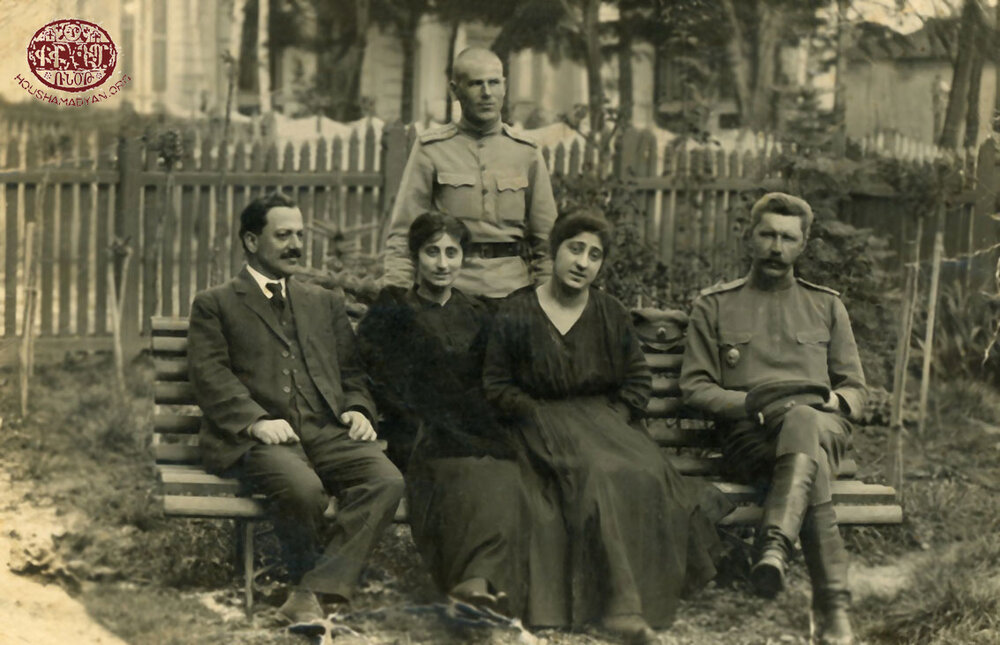
In 1915, the family lived in Kastamonu. His eldest son, Harutiun, was in Constantinople, so he was saved. Hovhannes and his son Vahram were deported and reached Aleppo and survived. After the Armistice, Hovhannes and Vahram on their way to Constantinople, stopped in Adana to visit Diruhi, his sister. Asanet, the mother, with the rest of the children were deported to a nearby village, yet all survived. The family left Kastamonu and their rendez vous was in Constantinople, as already Hovhannes’s father and sister were there. However, he would go to Kastamonu periodically, to collect dues from the Turks who owed him.
Harutiun Hovhannes Iynedjian moved to Romania and opened a store in Constanța (circa 1920), and the family followed him. Their elder daughter, Marie, was already betrothed before World War I to Haigazun Suzmeyan—the son of Asanet’s paternal uncle—who had settled in Kastamonu. They, too, moved to Constantinople.
The younger daughter, Ovsanna, and the three brothers—Haig, Nubar and Vahram Suzmeyan—settled in Bucharest. Haig and Nubar died there. Their mother, Asanet, became overwhelmed with grief. She also lost her eyesight. She, too, died and was buried in an Armenian cemetery in Bucharest.
Vahram was the only son of the family who survived into old age, as well as the two sisters, Marie and Ovsanna. [For Haji Harutiun Iynedjian’s other childrensee in POST II]
Nazaret Harutiun Iynedjian (born in Ottoman Empire, Kayseri circa 1872—died in Syria, near Aleppo during the Armenian Genocide) [See for POST II]
Bedros Harutiun Iynedjian (born in Ottoman Empire, Kayseri in 1874—died in Switzerland, Lausanne in 1961) [See for POST II]
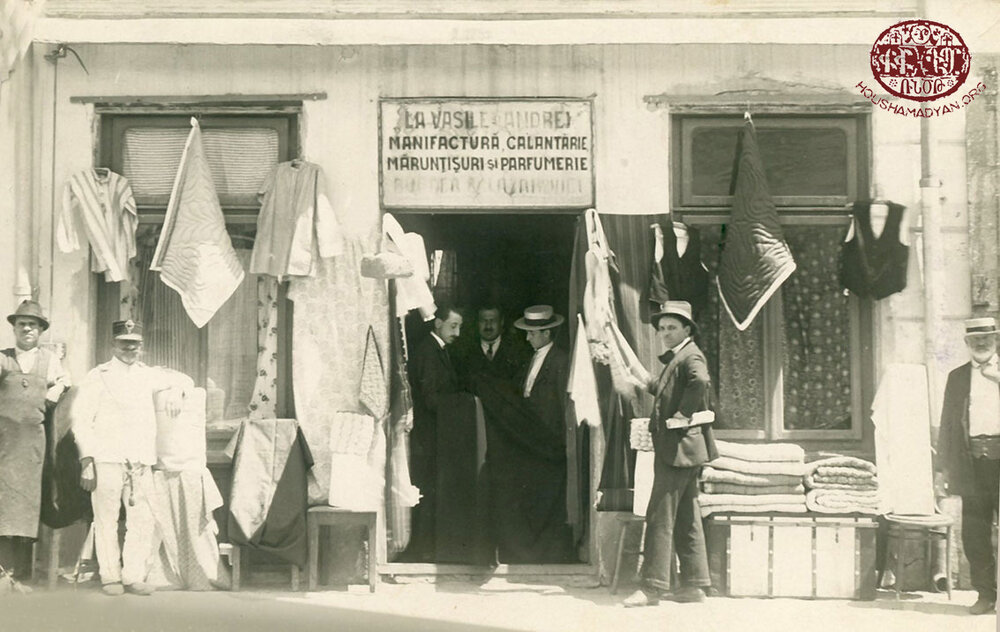

The Fourth Generation
Descendants of Antreas and Gyuldudu Bohdjelian
Mannik (née Bohdjelian Antreas) Bohdjelian (born in Ottoman Empire, Kayseri in 1873—died in USA, New York on May 8, 1971) married Hampartsum Allahverdian who was originally from Kayseri but moved to Banderma for financial opportunities; it is located on the eastern shore of the Sea of Marmara between Constantinople and Smyrna. [15] Hampartsum with his brother Taniel established a shop to mold fezzes in Banderma, along with other trades. They also traded in sheepskins and other animals. They built houses in Banderma and they owned orchards. However, a farm they bought gave them anxiety, long trials and financial loss. According to the chronicler of the Ashekian clan, the brothers were decent and devout men, loved by their community.
This couple had a son and two daughters, but Elizabeth died in infancy:
- Stepan Hampartsum Allahverdian (born in Ottoman Empire, Banderma on August 26, 1890—died in USA, New York on December 5, 1981)
- Louise Hampartsum Allahverdian (born in Ottoman Empire, Banderma in December 1900—died in USA, New York in 1965)
Mannik’s husband died before World War I, she relocated with her children to Constanța because her brothers, Avedis and Armenag Bohdjelian, were in Romania and were successful in their business. When she returned to Banderma to sell her properties, the Republic of Turkey had already confiscated everything.
When Romania entered into World War I, Mannik and her kin sheltered in Odessa, Russia. In 1918, they returned to Constanța, her son Stepan managed his uncle Avedis’s Dry goods shop and Mannik was the cashier. Then Avedis, with partners, built a textile factory called “Galatziana.”
In 1933, Avedis, with his sister Mannik and brother Armenag, built a huge building on Carol Boulevard in Constanța; the ground level was for commercial and retail space and the upper levels were apartments for rent. Later, they purchased another building at 69 Tomis Boulevard in Constanța and called it Hotel Paris.
Her son Stepan married Marie (née Misak Dilsizian) Allahverdian; the wedding in Constanța on February 4, 1934 was grand. The couple had a daughter, Vartuhi.
After World War II, Stepan with his wife and daughter resettled in Bucharest. About a year later, Marie died of cancer. Vartuhi was 11 years old and was raised by her grandmother Mannik. In 1947 Romania became a satellite of Soviet Union. Mannik’s wealth and that of her brothers’ descendants were confiscated. In 1963, Mannik, Stepan, Louise and Vartuhi arrived in Lebanon. About two years later, they left Beirut Airport in 1965. When the airplane landed in New York City, Louise who was gravely ill with cancer, died a few hours later.
Mannik was 92 years old when she arrived in the U.S.A. Her legs were weak and had difficulty to move; she could not see well and did not speak English. Her granddaughter, Vartuhi, helped as best as possible. She died in New York in 1971 and was buried with her daughter Louise at Cedar Grove Cemetery in Flushing, Queens.
Avedis Antreas Bohdjelian (born in Ottoman Empire, Kayseri in 1877—died in Romania, Bucharest on February 28, 1941) grew up in Banderma. In the reign of Sultan Abdul Hamid II, the Armenians suffered massacres from 1894 to 1896. To get the attention of the Europeans, the Armenian Revolutionary Federation ambushed the Ottoman Bank in Constantinople on August 26, 1896. However, their goals created more barbarities; there were gangs and riots assaulting the minority communities in the capital and there were massacres in the countryside. Avedis was 19 years old at that time and he forecasted the future was not secure anymore, so he settled in Constanța.
In Romania, Avedis quickly absorbed a few of the local languages and studied the trade of dry goods. Garabed Ashekian in his book writes, “He was a smart, alert, and hard-working young man, he soon managed to open his own store and he became a respected member of the community.” [16]
The Kingdom of Romania declared war on the sides of the Allied Powers (Russian Empire, France, and the United Kingdom) in August 1916 in World War I. However, they lost the Battle of Bucharest (December 13-16, 1916) and the Russian forces retreated to Moldavia. Romania was under the control of the Central Powers (Germany and Austria-Hungary and including the Ottoman Empire), so Avedis relocated to Odessa (Russian Empire) until the end of the war.
After the Armistice in 1918, Avedis settled in Galați and established seven shops in seven cities in Romania; they were all dry goods shops. One of them was in Constanța and he appointed his nephew, Stepan Allahverdian, the manager; eventually Stepan managed all of them. Next, Avedis with his partners, the Seferian brothers, built a textile factory. This company “Galatziana” was well known in the city.
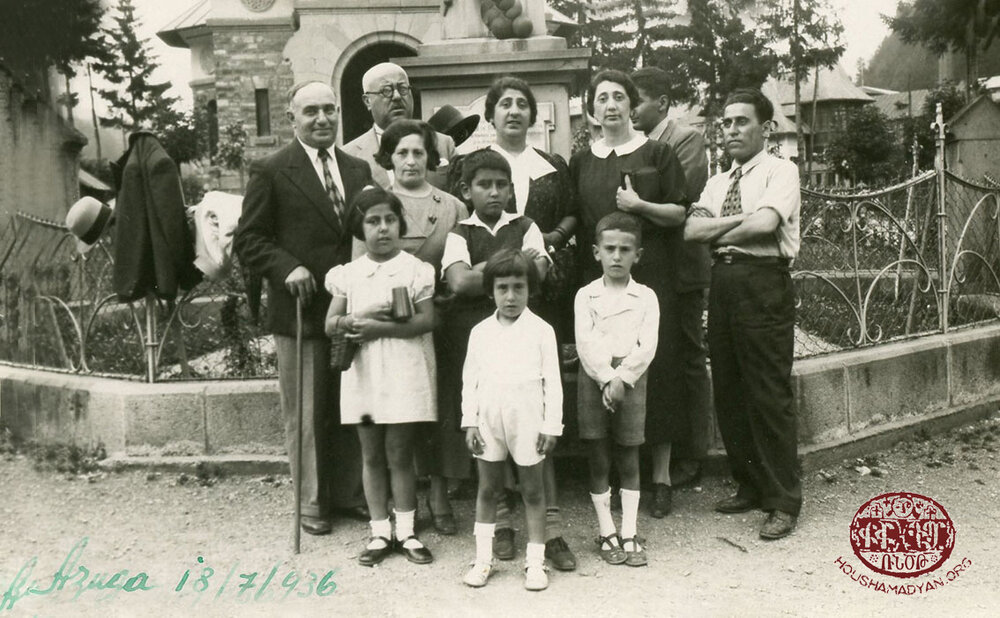
Circa in 1920, Avedis married Rozica (Rosa)(née Lazarovici) Avedis Bohdjelian (born in Romania, in August 1897—died in New York, USA in March 1986); her family was Armenian, lived in the city of Focșani, historically Moldavia now Romania, close to Galați. She had four sisters and four brothers.
This couple had a daughter born in 1923, but died in her infancy; then they had a son and a girl:
- Andrei Berdj Avedis Bohdjelian (born in Romania, Galați on April 12, 1925—died in USA, Philadelphia in 2005)
- Alice (née Avedis Bohdjelian) Bedrig Armenag Bohdjelian (born in Romania, Galați in 1928—died in USA, Philadelphia on December 24, 2020)
In 1933, Avedis, with his sister Mannik and brother Armenag, built a huge building on Carol Boulevard in Constanța; the ground level was for commercial and retail space and the upper levels were apartments for rent. Later, they purchased another building at 69 Tomis Boulevard in Constanța and called it Hotel Paris.
Avedis died prematurely on February 28, 1941 and was buried in Bucharest. On 30 December 1947, the Communist Party's power was consolidated, and King Michael abdicated, and Romania eventually became Socialist Republic. The government confiscated all private property, so Rozica and her children moved to Bucharest. Like most Armenians who left Romania, Rozica and Berdj went to Beirut and when their visas to the United States of America arrived, they went to Los Angeles in 1962. However, Berdj found a good job in New York in 1966 so they both moved. Rozica died at the age of 89 years old in Queens.
Armenag Antreas Bohdjelian (born in Ottoman Empire, Kayseri in 1879—died in Romania, Predeal [mountain resort] in September 1942) like most of the men of the Ashekian Clan from Kayseri, Armenag learned early on the skills of being an entrepreneur, first in Banderma. When the Balkan League (Serbia, Greece and Montenegro) fought against the Ottoman Empire and won (October 1912 to May 1913), Armenag relocated to Constanța. First, he became an exchanger and then a copper trader.
Around 1915, Armenag married Armenuhi (née Khachadur Semizian) Armenag Bohdjelian (born in Romania circa 1895—died in January 1934) her family was from Everek/Develi, a small town in Kayseri. During World War I, Armenag and Armenuhi went to Odessa, Russian Empire, but the brothers, Avedis and Armenag, were not idle, they would buy and sell to make a profit.
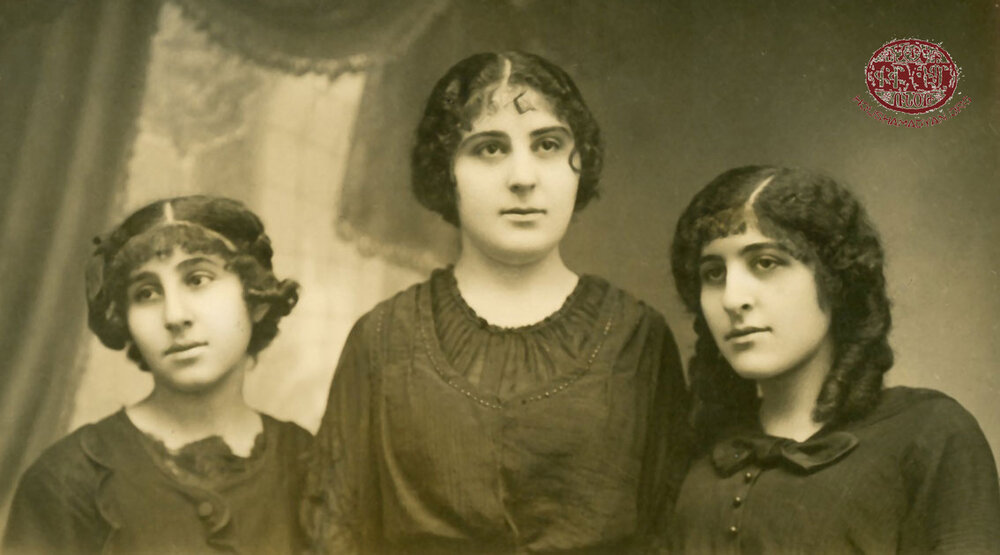
Armenag and Armenuhi had two sons; the third was a daughter who died in infancy:
- Bedrig Armenag Bohdjelian (born in Russia, Odessa, in 1917—died in USA, Philadelphia in 1984)
- Aram Armenag Bohdjelian (born in Romania, Constanța, in 1919—drowned in Romania, Lake Brateş on May 21, 1937)
At the end of the war, Armenag returned to Constanța and opened a store for gold silk. As a well-to-do person, he owned a house and an estate along with a clothing store. When Avedis established a factory in Galați, Armenag became a shareholder. He sold his house and stores to live in Galați. Next Armenag purchased a building in Bucharest to enjoy the capital city in peace and comfort. Unfortunately, his wife Armenuhi contracted tuberculosis and died in January 1934; they buried her in Constanța. [17]
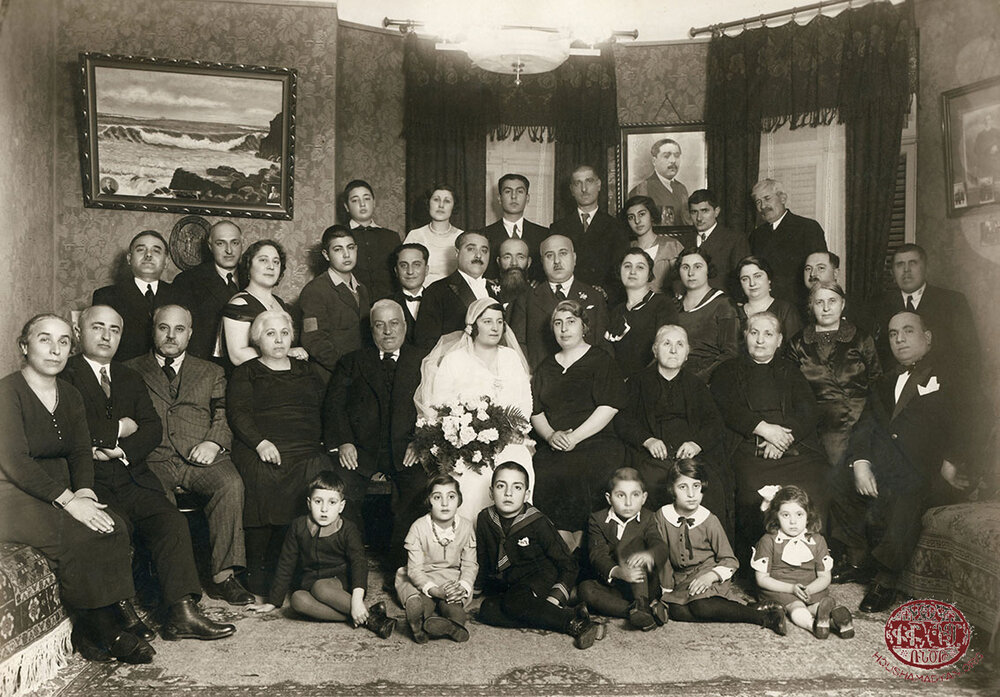
Children sitting on the carpet, from left: Baruir Garabed Ashekian, Aida Garabed Ashekian, Serko Karekin Ayanian, the boy and two girls are not known.
Seated from left to right: A woman not known, man not known, Armenag Antreas Bohdjelian [maternal uncle of the groom], Mannik (née Bohdjelian) Hampartsum Allahverdian [mother of the groom], Misak Dilsizian [father of the bride], Marie (née Misak Dilsizian) Stepan Hampartsum Allahverdian [the bride], Hripsimé (née Taniel Allahverdian) Karekin Ayanian [Matron of Honor/Gnkamayr), Gyuldudu (née Harutiun Iynedjian) Antreas Bohdjelian [grandmother of groom], Diruhi (née Harutiun Iynedjian) Parsegh Ashekian [sister of Gyuldudu], next woman not known [maybe the mother of the bride], Jacob (business manager of Stepan Allahverdian).
Standing first row, from left: Karekin Garabed Ayanian, Garabed Parsegh Ashekian, Louise Hampartsum Allahverdian [sister of the groom], Bedrig Armenag Bohdjelian, Harutiun Misak Dilsizian [brother of the bride], Stepan Hampartsum Allahverdian [the groom], a priest not identified, Avedis Andreas Bohdjelian [maternal uncle of the groom and the Best Man/Gnkahayr), Berjouhi (née Baghdasar Hovagimian) Garabed Parsegh Ashekian, Elena Harutiun Allahverdian, the next woman and two men are not known.
Standing, 2nd row, from left: Aram Armenag Andreas, Rozica Bohdjelian (wife of Avedis), Garbed Karekin Ayanian, Harutiun (Artin) Allahverdian, Hermine Karekin Ayanian, Malik Baltayan [brother of Garabed Baltayan], last man not known.
By November 1936, Armenag had married again to Aghavani (née Eranosian) Armenag Bohdjelian (born in Bulgaria, Varna in 1893—died in USA, Philadelphia in 1977). She was the widow of Mr. Benlian; both of her marriages did not beget children.
A tragedy came for Armenag on May 21, 1937. His youngest son, Aram, was swimming at a school holiday with his friends in Lake Brateş and got stuck in the mud and died. His friends tried to save him but failed. Later, his body was found, and he was buried in the cemetery of Galați. His body was later exhumed and laid to rest at the Armenian cemetery in Constanța near his parents.
A few years later, Armenag had cancer of the throat. He went to Vienna to find a cure, but it was useless. He returned to die in Predeal, a mountain resort in Romania, in September 1942. His body was brought to Constanța to be buried next to his first wife. He had purchased that lot with the intention of building a chapel and moving his son’s body there, but he ended up being buried there before he could realize his plans.
In 1947, the communist government in Romania captured Armenag’s estates. Armenag’s mother, Gyuldudu, his second wife Aghavani, and his son Bedrig lived in the building that he had purchased at 32 Spataru Street in Bucharest before 1934. Soon after, the government confiscated all this family’s wealth. Gyuldudu, died in 1957 in Bucharest.
In December 1962, Bedrig Bohdjelian, his wife, son, and his stepmother Aghavani went to Beirut to get their papers to enter the United States of America. They settled in the Greater Philadelphia area in December 1964.

The Fourth Generation
Descendants of Hovhannes and Asanet Iynedjian
Harutiun (Haigaz) Hovhannes Iynedjian (born in Ottoman Empire, Kastamonu circa 1896—died in Romania, Constanța) was in Constantinople during World War I, so he was saved. Then he went to Constanța and opened a shop. His family followed him to Romania. He died young.
Marie (née Hovhannes Iynedjian) Haigazun Suzmeyan (born in Ottoman Empire, Kastamonu on December 30, 1887—died in Los Angeles on November 23, 1982) married to Haigazun Suzmeyan (born in Ottoman Empire, Kastamonu circa 1890—died in USA, Los Angeles circa 1967) circa 1913. Like most of the marriages in the Ashekian clan from Kayseri, they were relatives; the groom was the nephew of Asanet (the bride’s mother), and like most of the sons he was apprenticed to become a businessman.
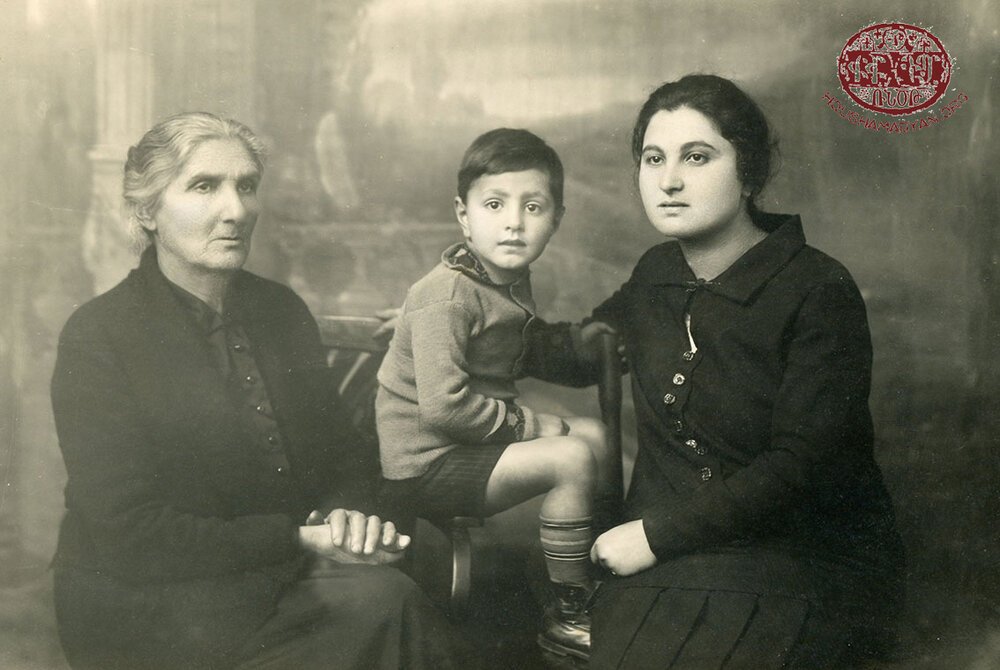
During the Genocide, Marie with her mother, Asanet, and her younger siblings—Haig, Ovsanna and Nubar—were deported to a village not distant from Kastamonu. Haigazun was mandated to do his military service, but it meant death. He hid in the houses of Greek and Turkish friends. In October 1918, the Mudros Armistice ended the war between the Allies and the Ottoman Empire. Haigazun reappeared and joined his wife and his family in Constantinople.
Haigazun found a home in Scutari/Üsküdar where Armenians, Greek and other minorities lived. He hired young women of the neighborhood to make embroidered women’s apparel that was to be sold to importers in the United States. His employees copied the sample he gave them in colors, design, and size and such. Next, his paternal uncle, Hampartsum Agha (Pérouze’s father) [see POST II], asked him to send oriental carpets to Bedros Iynedjian in Lausanne and he did. By the mid-1920s, Haigazun settled his family in Constanța because Mustafa Kemal (Atatürk) founded the Republic of Turkey in 1923 and made radical changes [see POST II].
When Haigazun’s brother Levon needed medical treatment, he took him to Switzerland. Before he left his family in Constanța, he had an arrangement with his sister’s son, Taniel Jamjian, to manage his haberdashery/dry goods shop. This young man failed in his charge; he instead opened a grocery store.
Haigazun’s sojourn was longer in Lausanne, where he opened a carpet store to pay his bills. When his brother Levon died in Switzerland, Haiguzan returned to Romania. His European experience made him miss living in an Armenian community, so he decided to establish his family in Bucharest because there were good Armenian schools for his sons.
Marie (née Hovhannes Iynedjian) and Haigazun Suzmeyan had four sons:
- Hagop Haigazun Suzmeyan (born in Ottoman Empire, Constantinople circa 1919—died young in Bucharest of appendicitis)
- Berdj/Berdje Haigazun Suzmeyan (born in Romania, Constanța on September 15, 1918—died in USA, on Los Angeles, October 21, 2000)
- Hagop/Jacob Haigazun Suzmeyan (born in Romania, Bucharest, on September 20, 1925—died in USA, Los Angeles on August 2, 2010)
- Levon/Leo/Leofet Haigazun Suzmeyan (born in Switzerland on December 30, 1926—died in USA, Los Angeles on September 2, 2004)
Marie and Haigazun’s first child, Hagop, had appendicitis. They took him to a hospital in Bucharest, but he died during the operation. They buried him in the Armenian cemetery of Constanța. When another son was born, they called him Hagop, as well.
Their sons were placed in the Sighisoara German boarding school where they learned new professional skills. When Romania became a Socialist Republic in 1948, Haigazun lost property, just as all Armenian businessmen, lost shops, factories, properties and houses. This family was lucky to leave Romania early because they were subjects of Iran. As soon their exit visa arrived, they traveled to Beirut in 1951. After a few years, Levon decided to immigrate to the United States, and then his brothers followed him and brought their parents as well. They all settled in Los Angeles and the parents died in California.
Vahram Hovhannes Iynedjian (born in Ottoman Empire, Kastamonu on May 28, 1901—died in USA, Los Angeles on April 21, 1983) was the only son of Hovhannes and Asanet who survived into old age. During the Genocide, Vahram and his father were deported and reached Aleppo and survived. Vahram and his father Haigazun stopped in Adana/Mersin to see their relatives, on their way to Constantinople.
Vahram’s eldest brother, Harutiun Hovhannes Iynedjian, opened a store in Constanța circa 1920 and his family followed him. After the death of Harutiun, the family relocated to Bucharest.
Vahram, an amusing man, did not marry. After his sister Ovsanna married Hagop Parsegh Ashekian in 1929, Vahram and Hagop became brothers-in-law, but more importantly they were business partners until their last days. Hagop asked his brother-in-law in Beirut, Sarkis Bakalian, to invest in a large grocery shop in Bucharest and Sarkis sent the funds. Hagop and Vahram ran the grocery on Piatsa Grevitsa until World War II. Then Hagop and Vahram bought a machine to make socks and hosiery from their home. In 1944 Soviet troops entered Romania and the country became a satellite of the Soviet Socialist Republic (SSR) in 1947. Hagop and Vahram were compelled to work in cooperatives.
After a decade of misery in Romania, Hagop obtained visas for his family to go to Lebanon. In 1959, Hagop, his wife Ovsanna, his son Pakrat and his brother-in-law Vahram arrived in Beirut. By that time, the Bakalians had relocated to a modern building with an elevator in Badaro. Hagop’s family settled in their old apartment in Khandaq al-Ghamiq, Bashoura, in downtown Beirut.
Hagop’s older brother, Garabed, had left Romania for Beirut in 1951, they lived in Mar Mikael/Beirut and started a coffee business in his nephews’ flourmill in Karantina. Garabed’s offspring left Lebanon first, then the parents followed in 1959. Vahram Iynedjian and Hagop Ashekian took over the coffee roasting and grinding work from his brother Garabed. In 1961, Vahram with Hagop and his family settled in Los Angeles.
Haig Hovhannes Iynedjian (born in Ottoman Empire, Kastamonu circa 1906—died in Romania, Bucharest) was a child during World War I, his mother and his siblings were deported to a village close to their home in Kastamonu. He moved with his family to Constantinople, and then set off to Constanța. He died young in Bucharest.
Ovsanna (née Hovhannes Iynedjian) Hagop Ashekian (born in Ottoman Empire, Kastamonu on August 3, 1907—died in USA, Los Angeles on January 22, 2001) was about eight years old when the Genocide started. She was deported with her mother, Asanet, and her elder sister, Marie, and brothers Haig and Nubar, to a village not far from their home in Kastamonu. They later joined their father and brother Vahram in Constantinople. As her eldest brother, Harutiun, was established in Constanța, the rest of the family moved to Romania. She must have been in educated in Romania.
Ovsanna married Hagop Parsegh Ashekian (born in Ottoman Empire, Adana in 1901—died in USA, Los Angeles on January 10, 1989) on April 4,1929. The groom and bride were the grandchildren of Haji Harutiun Iynedjian; Hagop’s mother was Diruhi (née Haji Harutiun Iynedjian) Parsegh Ashekian and Ovsanna’s father was Hovhannes Harutiun Iynedjian.
The couple had a son:
- Hovhannes-Pakrat Hagop Ashekian (born in Romania, Constanța 1930—died in USA, Los Angeles in 1996)
In fall 1959, Ovsanna, Hagop, their son Pakrat and Vahram arrived in Beirut. They waited for about two years to procure their documents to enter the United States of America. In the meanwhile, they lived in the apartment in Khandaq al-Ghamiq. Traveling with them were—Hripsimé’s eldest son and daughter’s families—who also lived with them in in the same apartment.
Pakrat, Hagop and Ovsanna’s son, worked for Malifer Corporation (owned to the Malikian family), while Hagop and Vahram continued Garabed’s coffee business.
Ovsanna, Hagop, Pakrat and Vahram arrived in Los Angeles in 1961. The men worked hard until they bought a house on Moorpark Street in Encino. Ovsanna enjoyed her kitchen and her garden. Her son married and had two sons, Haig and Sarkis. She survived her husband, brother, son and daughter-in-law.
Nubar Hovhannes Iynedjian (born in Ottoman Empire, Kastamonu circa 1913—died in Romania, Bucharest) was a baby during World War I. His mother and his siblings were deported to a village close to their home in Kastamonu. Then his mother took him to Constantinople where his father and brother Vahram were residing. Then they moved to Constanța, where he died young in Bucharest.

The Fourth Generation
Descendants of Taniel and Nevrig Allahverdian
Hripsimé (née Taniel Allahverdian) Karekin Ayanian (born in Ottoman Empire, Banderma, circa 1883—died USA, Knoxville, TN, on January 12, 1984) [18] married Karekin Garabed Ayanian (born in Ottoman Empire, Banderma—died in Romania, Constanța in 1947) before World War I.
Karekin was a teacher in an Armenian school in Banderma. Then he taught in the Armenian school in Constanța. When on August 27, 1916 the Kingdom of Romania entered World War I on the side of the Allies, Hripsimé, Karekin and their son Garabed went to Odessa, Russia, where their relatives were residing. Karekin started to trade goods, making a profit. Their daughter, Hermine, was also born there.
After the war in 1918, the Ayanian family went to Constantinople, where Hripsimé’s parents, her sister Nevart and her brother Kevork where living. Karekin took a table in a pivotal location of Mahmutpaşa Çarşısı/Market (between Grand Bazaar and Eminönü) and sold fabrics.
When Mustafa Kemal became the first President of the Republic of Turkey and Ankara its capital in 1923, his radical reforms frightened the Armenians. Hripsimé and Karekin left their children with her mother and went to Lausanne to visit her uncle Bedros Iynedjian and his wife Pérouze. They explored their opportunities for their future, and maybe were not encouraged to stay.
The couple returned to Constantinople to pick up their children and settled in Constanța for the second time where their last child was born. Karekin partnered with Garabed Ashekian to traffic grain. After a couple of years, they separated. Then Karekin opened a fabric store, and it was successful.
Hripsimé and Karekin had three children.
- Garabed Karekin Ayanian (born in Ottoman Empire, Banderma on September 7, 1914—died in USA, Philadelphia, on November 21, 1991)
- Hermine (née Karekin Ayanian) HagopDjirikian (born in Russia, Odessa, on May 12, 1918-died in USA, Knoxville, TN, on February 12, 2014)
- Serko Karekin Ayanian (born in Romania, Constanța, on December 15, 1923—died in USA, Jamaica (NY) on May 26, 2019)
Karekin had chest pains; his doctors told him it was Angina. He died and was buried in the Armenian cemetery of Constanța in 1947. Also, that year was when Romania became a Socialist Republic. The majority of the population lost their wealth and businesses. Hripsimé and her children relocated to Bucharest. In spite of the political climate, Garabed, Hermine and Serko got married and gave Hripsimé five grandchildren. Still their tenacity had limits; all the Ayanians/Djirikians left for Beirut in late 1960. Hripsimé, Garabed, his wife and son; and Hermine, her husband and son lived with Hagop Ashekian’s family in the former apartment of the Bakalians in Khandaq al-Ghamiq. Serko’s family, wife and three daughters rented an apartment. It took a little over a year for ANCHA to get their papers to enter the United States.
In 1961, Hripsimé, along with Garabed’s and Hermine’s families settled in Philadelphia. Serko’s family eventually settled in New York. When Hermine’s son, Ara Djirikian, found a job in Knoxville, TN, Hripsimé moved with them and lived there until her death. She was buried in Knoxville; what a journey!
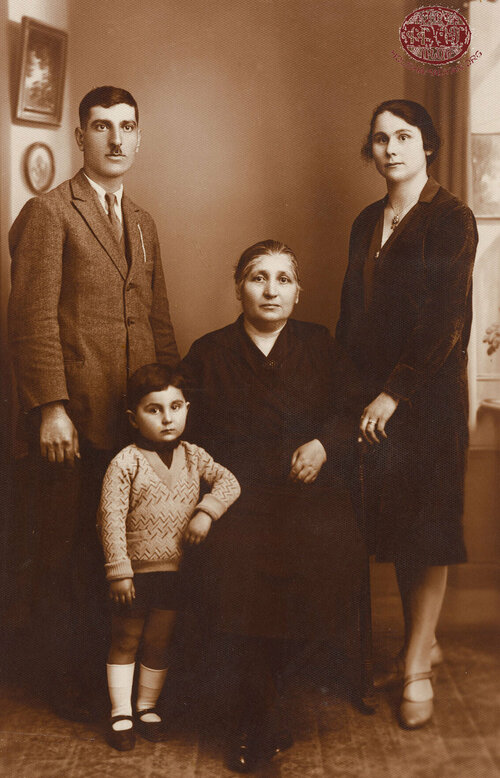
Harutiun (aka Artin) Taniel Allahverdian (born in Ottoman Empire, Banderma circa 1885—died in Armenia, Yerevan, in the 1970s) grew up in Banderma and lived there until circa 1913. As his family relocated to Constanța, he joined them. When the Kingdom of Romania entered on the side of the Allies on August 27, 1916, he followed his relatives to Odessa (Empire of Russia).
Like most of the Ashekians from Kayseri, Harutiun would buy and sell for a profit. However, he was unique to join Armenian volunteer units: First, he joined the Russian Imperial Army until 1917, and then he observed the Russian Revolution (March 8, 1917 to November 7, 1917). Next, he went to Yerevan to witness the First Republic of Armenian (1918-1920). From there, he went to Constantinople and from there to Cilicia. He volunteered in the French Armenian Legion (La Légion Arménienne) in the Franco-Turkish War, also known as the Cilicia Campaign (La campagne de Cilicie). After several battles by October 1921, the French abandoned the Armenians in favor of supporting Turks. Harutiun returned to Constantinople to see his mother, sister and brother, and from there, he went to Constanța.
Around 1924, Harutiun married Elena (née Not Known); a native of Chernivtsi (Western Ukraine), her ancestors were Polish; at the turn of the 20th Century, both Romanian and Ukrainian national movements started in this area.
The couple had two sons:
- Taniel Harutiun Allahverdian (born in Romania, Constanța in 1927—died in Armenia, Yerevan)
- Stepan Harutiun Allahverdian (born in Romania, Constanța in 1931—died in Armenia, Yerevan)
According to Garabed Ashekian in his book, he mentions that Harutiun Allahverdian was occupied in profitable deals during the war years and his Russian language skills helped him.
The Soviets called for repatriation, Nerkakht in Armenian, because they had lost a significant amount of the population during World War II. On November 25, 1945, radio announcements disseminated the news from Moscow, Yerevan, Bulgaria, Romania, London, Paris and Beirut. Soviet delegates were sent to Armenian communities in the diaspora to manage the relocation and assist local boards. From 1946 to 1948, “2,866 Romanian-Armenian” [19] repatriated to Armenia SSR; among them was the Harutiun Allahverdian’s family.
Harutiun’s wife Elena must have been a very kind woman and took good care of her sons. In Armenia, she integrated to a new culture and learned the Armenian language. They lived in Nor Arapgir, a district at the north of Yerevan. Harutiun sold tramway tickets and Taniel and Stepan fixed watches at home. Both the sons got married and each built a private house and had children. In the 1960s, Harutiun was retired and received a pension from the government.
In The History of Uzun Ashekian, the author Garabed Ashekian describesHarutiun as a sneaky and crafty person, “living through deals he strikes in the streets. He earns well but spends unwisely.” [20] That may have been one opinion; however, one can say that if Harutiun had lived in different times, he may have become an officer in the army. For sure, he was not a sheep.
Nevart (née Taniel Allahverdian) Garabed Baltayan (born in Ottoman Empire, Banderma circa 1889—died in Turkey, Istanbul circa 1965) [See POST II]
Kevork Taniel Allahverdian/after 1923 Allahverdi (born in Ottoman Empire, Banderma in 1891—died in Turkey, Istanbul on May 8, 1970) [See POST II]

The Fourth Generation
Descendants of Parsegh and Diruhi Ashekian
Garabed Parsegh Ashekian (born in Ottoman Empire, Adana on October 13, 1889—died in USA, Southern California in 1983) is the author of The History of Uzun Ashekian; his father was the grandson of the patriarch who settled in Kayseri. His father Parsegh was the first to establish commerce relationships and prosper in Adana; his brothers, Dikran Parsegh Ashekian, Mihran Ashekian (see POST I) and others followed him. Garabed lived in a large complex, adjacent to the Holy Mother of God Armenian Church and its high bell tower in Adana. In one part of this building was his family—father Parsegh, mother Diruhi, sister Haiguhi and Marina and younger brother Hagop. His uncles, Dikran and Mihran, and their families, as well as his grandfather Parsegh and grandmother Hripsimé lived in different sections of the house.
Garabed attended the Armenian Apkarian School in Adana and continued at a French school. Garabed was 16 years old when his father died in 1901, and his mother, Diruhi, was pregnant with his brother Hagop. He started to manage the farm and real estates of his father; and soon later, he became an apprentice with his cousin Murad Dikran Ashekian (see POST I) at the office of the lawyer, Mihran Effendi Kasarjian, to learn how government contracts work.
Being the sons of a rich family, the cousins Garabed and Murad Ashekian, were spoiled; they owned horses, followed women and liked to collect photography. In his book, Garabed tells the story of the horse he owned after his father’s death. It was a three-year-old colt. Many people wanted to buy this horse, but one day, Djemal Pasha the vali/governor-general of Adana after the Armenian Massacre of 1909, saw the horse and wanted to buy it. Garabed was in Cairo, so his uncle Dikran Ashekian managed the sale. The Pasha paid 25 gold coins for the horse (they had bought it for 14 gold coins) and sent it on a board of a ship to Constantinople. More importantly, later on Djemal Pasha saved the lives of Dikran Ashekian’s family; who spent most of the war in Aleppo. [See POST I]
The Adana Massacre started on April 13, 1909, Garabed with his mother Diruhi were visiting relatives in Cairo. His siblings witnessed the massacres [see POST I]; they escaped from their house. When they returned, nothing was left. The Ashekians moved their home to Mersin; the men would spend the week in Adana, and commute to Mersin on Sundays and holidays.
Dikran Ashekian and his brother-in-law Sarkis Bakalian bought a modern, mechanical flourmill from Zurich in 1908 and then chartered the “Ashekian-Bakalian” firm on January 1, 1909. [See POST I] When the Ottoman Empire entered World War I, its Army commanded the Ashekian-Bakalian flourmill in Adana. It was fortunate because Garabed Ashekian, as well as the men of the Uzun Ashekian from Kayseri who were in Cilicia, were exempt from both military service and deportation. Each “employee” had an assignment in the factory and the Ottoman Empire Office often inspected the ledger. World War I ended for the Ottoman Empire on October 30, 1918 with the Mudros Armistice.
Throughout War World I, a high officer was overseeing the Ashekian and Bakalian flourmill. In 1919, this officer gave the Ashekian-Bakalian families a tip to evacuate quickly. Almost all the families went to Cyprus, but Garabed in his book does not say if he left. It is clear that he was in Cilicia until 1920.
After the World War I, Cilicia was occupied by the Allied (British, then French) forces and a new life started for the Armenian survivors of the Genocide. Garabed Ashekian took leadership responsibly in Adana from 1918 to 1920. Once the first Armenian National Union resigned, a second Armenian National Union was formed and three men—Yesayi Bezdikian, Setrak Gebenlian, and Garabed Ashekian— administered its responsibilities. Also, Ashekian got the position of treasurer; in his book, he mentions that he got that post because he did not belong to any Armenian political party. The French had designed the Fifty-Men-Strong-Militia to monitor the neighborhoods of Adana, and Garabed Ashekian was the commander.
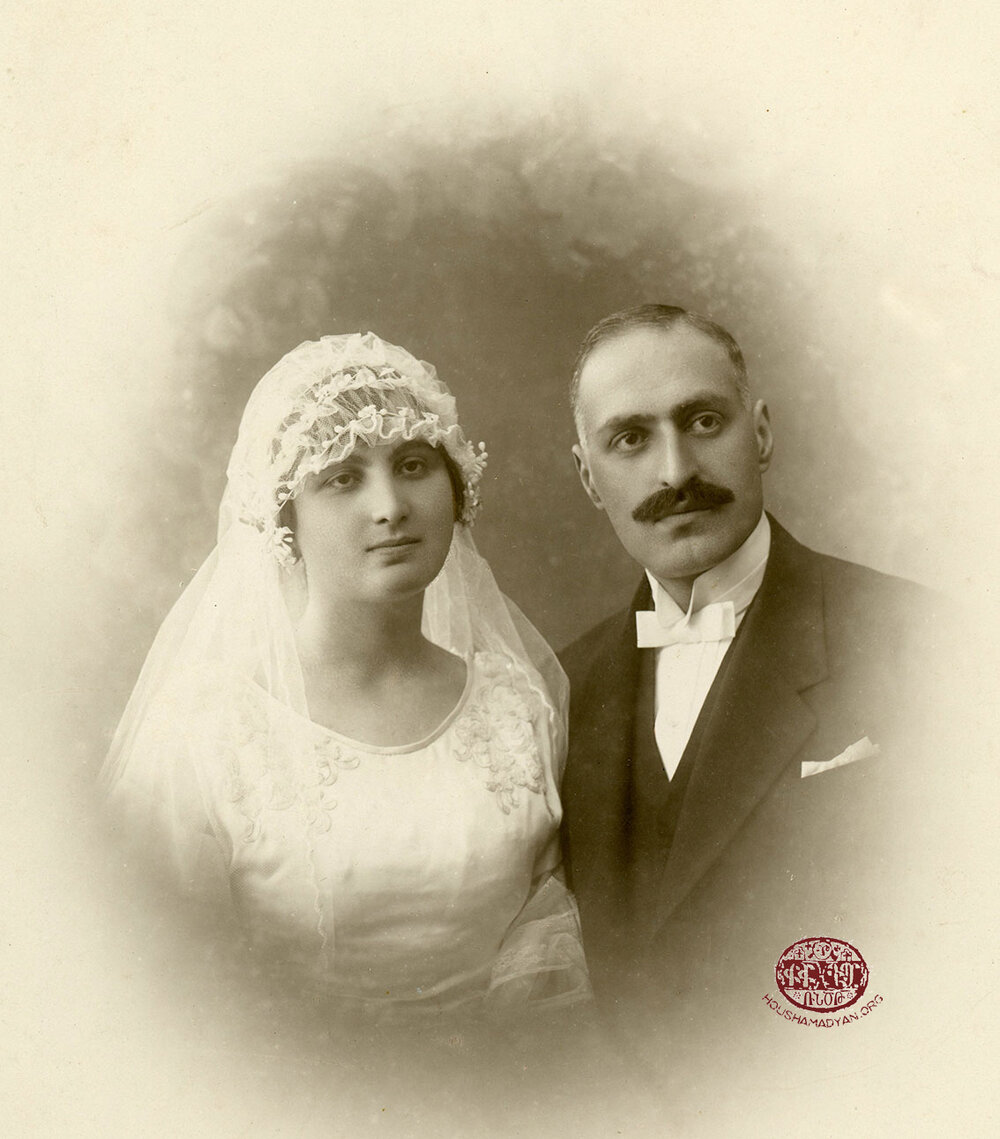
On September 20, 1920, the six members of the Armenian National Union, including Garabed Ashekian, were exiled to Iskenderun because the French were no longer supporting the Armenians. When they reached Iskenderun, they were not allowed to go to Damascus or Beirut. Garabed explains in his book that he was born in Adana and lived there until that time, but with the new regulations, if he went to Adana, he would have been jailed. The officials in Iskenderun gave him a permit to go to Constantinople. In the capital, he appealed to the French to get a permission to visit Adana, but his request was declined.
Garabed married Berjouhi (née Hovagimian) Garabed Ashekian (born in Ottoman Empire, Kartal [Marmara Sea, Istanbul], on May 1, 1895—died July 24, 1983 in Canada, Sherbrooke) in Constantinople on April 18, 1921.Berjouhi was the youngest daughter of Baghdasar and Zaruhi (née Baronian) Hovagimian and she had two sisters—Fransuhi, Roxane and a brother Hrant. The Hovagimians lived in Kartal (on the coast of the Marmara Sea/close to Büyükada, the largest Princess Islands); her father had a farm, fruit trees, cows, sheep, etc. After graduating from the Armenian school of Kartal, Berjouhi completed her education at the American Hayuhyats School of Adapazarı.
Berjouhi told her grandchildren that their grandfather asked her three times to marry him, before she finally agreed. She was fluent in Armenian, Turkish and English. She was interested in ideas, books, writing and lecturing, unlike most of the women of her time. Berjouhi also kept in touch with her school friends by letters, photo cards, and when she immigrated to Canada her children took her to Boston to have a reunion with Vergine, Nazeli and Rose. She also founded literary organizations in Constanța and Beirut. The majority of Armenian women of her generation were proud of their skills in cooking, baking and make their home and their children attractive with their knitting, embroidery, crochet and tatting skills; however, Berjouhi had other values.
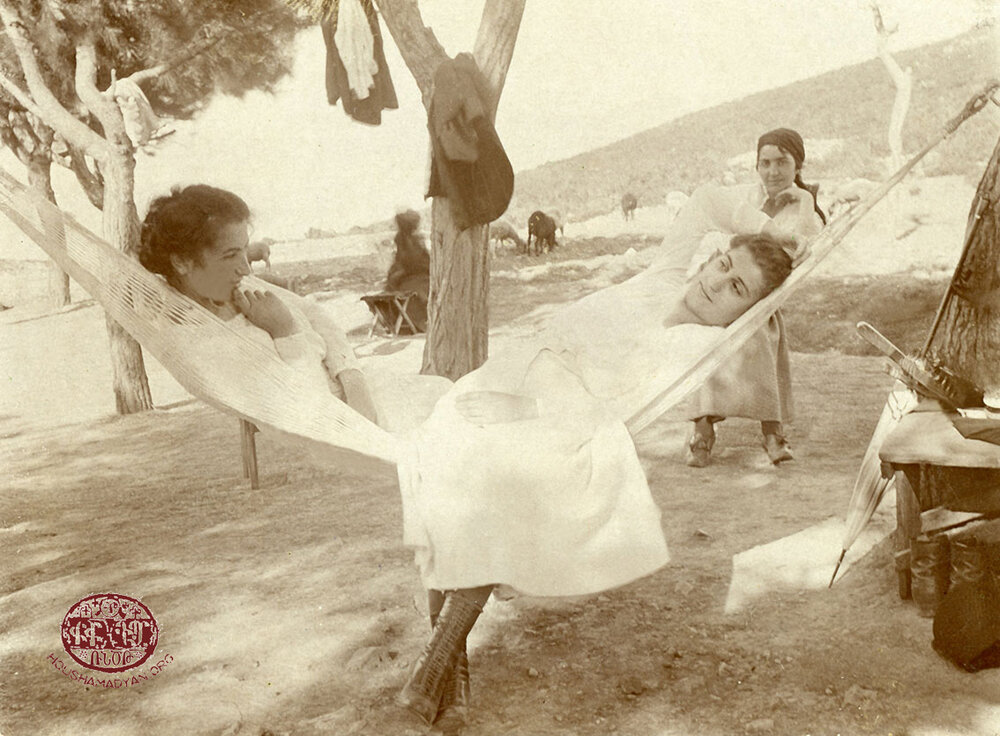
After their wedding, Garabed took Berjouhi to Larnaca in Cyprus to introduce her to his mother, his brother Hagop and his sisters, Haiguhi Bakalian and Marina Ashekian and their relatives [See POST I]. After a second year in Cyprus, Garabed wanted to return to Constantinople because the summers are very humid in Larnaca and he was hoping to return to Cilicia. He took his wife Berjouhi, his mother Diruhi, and his brother Hagop and left for Constantinople.
Garabed Ashekian realized that it was dangerous for him to stay in Constantinople, especially that his name was on a blacklist. Garabed, Berjouhi, Diruhi and Hagop boarded a ship that sailed at night from Constantinople to Constanța. Already many of the Ashekians from Kayseri had settled comfortably in Romania and prospered. While Garabed’s passion was for Armenian politics in the Ottoman Empire, he had the duty to care for his family; he and his brother Hagop started the trade of grains in Constanța.
Berjouhi and Garabed had three children, a boy and then the twins, a girl and boy:
- Parsegh-Mher Ashekian (born in Romania, Constanța in 1923—drowned in Mamaia in 1931)
- Aida-Zaruhi Garabed Ashekian (born in Romania, Constanța on November 13, 1927—died in USA, Southern California on April 24, 2001)
- Baruir-Baghdasar Ashekian (born in Romania, Constanța on November 13, 1927—died in Canada, Ottawa in 2006)
In 1929, Berjouhi took her mother-in-law Diruhi and her son Parsegh and the twins, Aida and Baruir and went to Larnaca, Cyprus, to visit her sisters-in-law, Haiguhi Bakalian and Marina Ashekian and their children. The twins were too small to play with their cousins, Mampile, Chaké, Vasken and Sirarpie, but Parsegh enjoyed his time.
Parsegh was bright and had a promising future. Alas, he drowned at Mamaia Beach (North of Constanța on the Black Sea) while the family was sunbathing.
Aida and Baruir attended the Constanța schools, there they learned Romanian and later French. The twins spoke Armenian with their parents and Turkish with their grandmother Diruhi. Haiguhi (née Ashekian) Bakalian had become a widow in 1937, the following summer she traveled to Romania with her daughter Mampile (age 19), son Vasken (age 17) and her niece Chaké (age 17) [the daughter of her sister Marina Ashekian]. They visited relatives in Constanța and Bucharest. When they returned to Beirut, Diruhi was with them on the ship.
After high school, Aida and Baruir attended university in Bucharest. Aida became a pharmacist and Baruir an engineer, specializing in airplanes.
Between the two world wars, development in industry and urbanization increased in Romania, but the development was uneven. Once Romania became a Socialist Republic on December 30, 1947, the regime changed radically from modern liberal political and economic model to a totalitarian regime. The party established “Securitate” (Department of State Security) and Sovietization or Russification took place until 1960.
Garabed Ashekian asked his nephews Pakrat and Vasken Bakalian to issue Lebanese citizenship for his family and they did. Garabed, Berjouhi, Aida and Baruir left from Constanța by ship and arrived in the Port of Beirut in June 1951.
His sisters Haiguhi and Marina, his mother, and nephews and nieces welcomed Garabed and his family to Lebanon. They found a first-floor apartment in Mar Mikael across Saint Mikael Maronite Church (south of Bourj Hammoud). Haiguhi paid Aida’s tuition to attend the Faculte de Pharmacie à Université Saint-Joseph de Beyrouth. Baruir found a job with Middle East Airline and worked at Beirut airport.
Garabed’s nephews gave him a small space in the flourmill in Karantina for his coffee business. He would buy coffee beans, roast them and grind and then sell them. Garabed emigrated to Canada in 1959, few months later, his brother Hagop and his brother-in-law, Vahram Iynedjian, took over the coffee business.
Berjouhi was happy in Beirut because she was involved with the activities of the Veradznoont (renaissance); the club was few blocks from their home by foot. Veradznoont was established in the late 1940s for independents that were not members of any Armenian political parties (Tashnag, Hunchag and Ramgavar) and their goal was to introduce the Armenian and Arab cultures to each other. Pakrat Bakalian was one of the founders and leaders of Veradznoont. [See POST I]
Berjouhi joined the ladies outing to Azounieh Sanatorium, to Surp Asdvadzadzin/Saint Mary Chapel and Seminary in Bikfaiya, and attended the lectures, concerts as well as the Gaghant Baba/Santa Claus for impoverished children.
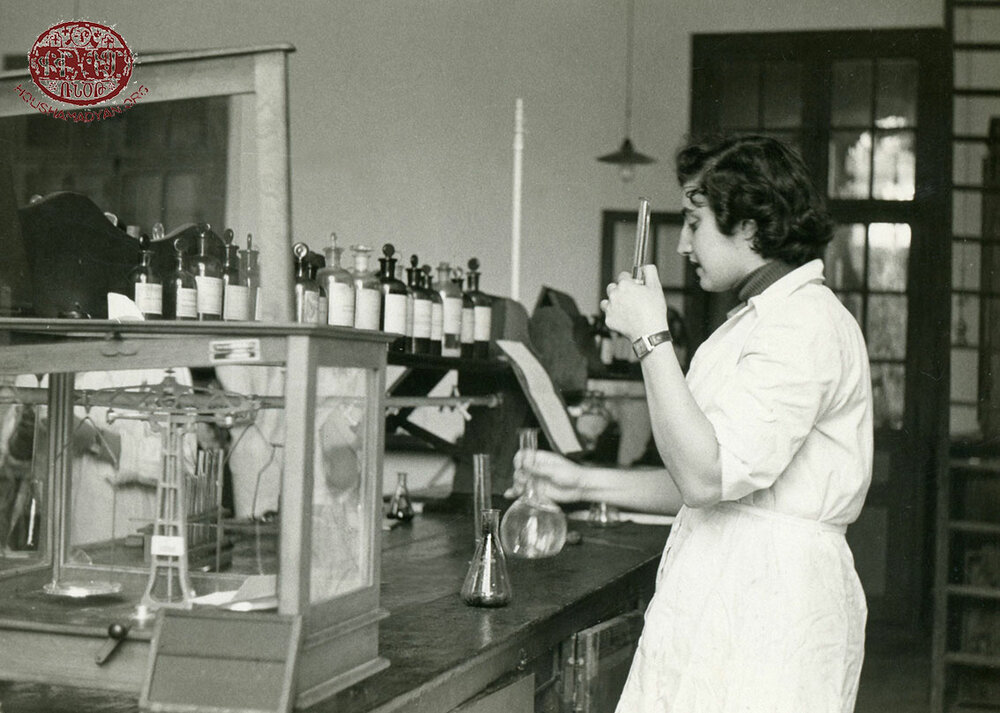
Baruir Ashekian, who had emigrated to Canada, urged his parents to immigrate and live with him. He had rented a house near the airplane company in the Iberville village of Saint Jean city, Montreal. Aida had married Hagop Lafdjian at St Gregory Illumination Church, Saint Catherine, QC, in January 1959. Then her husband received a good appointment in Los Angeles and Aida followed him. Baruir married Angel Bedirian on December 17, 1960 in Montreal.
Garabed and Berjouhi had five grandchildren, they taught them to speak Armenian, and even tried to teach them to read and write Armenian.
Berjouhi and Garabed visited their daughter, Aida, in Santa Ana, South California, where she had a house. Unlike Montreal, many Armenians and relatives lived in Los Angeles and they enjoyed visiting with Hagop Ashekian, his wife Ovsanna and his brother Vahram, the son of Marie (née Iynedjian) Haigazun Suzmeyan. They also received visitors from New York and Philadelphia.
Garabed was born to a privileged family who gave him an education considered the best at that time; he traveled several times with his mother and enjoyed riding horses with his cousin Murad Dikran Ashekian. He was lucky that he was not conscripted to the Ottoman Army nor deported during the Armenian Genocide. Nonetheless, he witnessed two world wars and Joseph Stalin’s harsh rule in Romania. He dabbled in commerce, but his heart was not in it. In peaceful times, he might have been a politician.
He was 70 years old when he arrived in Canada. During his “retirement,” Garabed P. Ashekian took the opportunity to write a book in Armenian The History of Uzun Ashekian. His daughter, Aida, lovingly paid the price of the publication at Donikian Press in Beirut and the volume appeared in 1968.
Garabed writes in his book, “We pass our time with our son and our grandchildren. Sherbrooke is a city of 80,000 inhabitants and we are the only Armenian family there. There is only one arabophone, Armenian Catholic doctor from Mardin. He lives with his mother and his niece Marie Besmargian who is a physician. The absence of Armenians is annoying for us, the elderly, but worse is that the children are growing up in a non-Armenian environment.” [21]
No doubt, Garabed put serious focus on his book; it was his legacy not only for his grandchildren, but the descendants of Allahverdian, Ayanian, Bakalian, Baltayan, Bohdjelian, Kazandjian, Iynedjian and other descendants; we are all indebted to him.
When Berjouhi died in Sherbrooke, where her son Baruir was a professor of aerospace engineering at the Université de Sherbrooke, Garabed Ashekian moved to southern California to live with his daughter Aida. One day, when Aida was at work, he fell and fractured his hip. He was hospitalized but passed away shortly later. He was cremated in California.
Haiguhi (née Ashekian) Sarkis Bakalian (born in Ottoman Empire, Adana, March 24, 1892—died in Lebanon, Beit-Mery in 1966) [See POST I]
Marina (née Ashekian) Bedros Ashekian (born in Ottoman Empire, Adana 1896—died in Lebanon, Beirut in 1974) [See POST I]
Hagop [Akop] Parsegh Ashekian (born in Ottoman Empire, Adana, on May 15, 1901— died in USA, Encino (CA) on January 10, 1989) lived with his siblings—Garabed, Haiguhi, and Marina—in a big complex with a large courtyard in the middle with grandparents, aunts and uncles and cousins. Their house was located next to Holy Mother of God Armenian Church in Adana. Included in their home were his grandfather Garabed Uzun Ashekian and his wife Hripsimé; their three sons Parsegh, Dikran, and Mihran with each of their wives and children.
While the Ashekians lived in Adana, they were proud to be from Kayseri and always mentioned their roots. All their children were born in Adana, except Adele and Murad Dikran Ashekian. Parsegh, Dikran and Mihran Ashekian had a child each in Adana in 1901.Parsegh’s son Hagop was born after his death. Tsoline was Dikran and Marie Ashekian’s last child. Louise was the second daughter for Mihran; hedied unhappy because he did not have a boy. [See POST I]
Hagop received his elementary education at the Armenian school in Adana. After the Adana Massacre in April 1909, his family moved to Mersin. The men worked in Adana and commuted to Mersin on Sundays and holidays.
In 1913, his family took Hagop to Constantinople where he was enrolled as a boarding student at the American Robert College. Before the completion of the first year, his family received a letter from the principal, saying: “Do not send him back next year. He is not prepared for our school.” [22]
Hagop returned back to Mersin during the school holiday. The next year, he attended the American College in Tarsus/Darson; a family friend’s son, Kevork Damlayan was enrolled there. Soon later, the government appropriated this institution on pretense to make space for the troops that a war was coming. Again, Hagop returned home.
In the commotion of World War I, his family sent Hagop to Adana to stay with American missionaries who also had a pharmacy. They thought that the missionaries could keep him protected; also, he could improve his English. On November 5, 1914, the Ottoman Empire entered World War I and its Army commanded the Ashekian-Bakalian flourmill in Adana. Members of the Ashekian, Bakalian and other relatives who were on the employee list were not conscripted nor deported. After the Mudros Armistice, Hagop went to Constantinople to study at Berberian College.
Throughout of War World I, a high officer was overseeing the Ashekian and Bakalian flourmill. In 1919, he told Sarkis Bakalian (who was one of the two founders of the flourmill, the other Dikran Ashekian was with his family in Aleppo) [See POST I] to leave Cilicia as soon as possible. Within two days, they carried whatever they could bring with them from Adana and Mersin to Cyprus. Of course, they left the flourmill, their houses, properties and farms, and anything they could not carry. Hagop joined his sisters Haiguhi and Marina, his mother Diruhi and cousins.
In 1921, Hagop’s eldest brother, Garabed Ashekian, got married in Constantinople. After the wedding, he took his wife to Cyprus, to introduce her to his mother, Diruhi, and sisters, Haiguhi and Marina, and the rest of the Clan. Berjouhi and Garabed must have stayed in Cyprus a little over a year. They found the humidity uncomfortable in the summer, they decided to leave Larnaca. Garabed decided to settle in Constantinople; traveling with him was Berjouhi, his wife, Diruhi, his mother and Hagop his younger brother. After the Smyrna/Izmir fire in 1922, Garabed understood that he could not live safely in the Ottoman Empire anymore. The Ashekians took an overnight ship to Constanța, where the brothers began a grain business.
On April 4, 1929 in Romania, Constanța, Hagop Parsegh Ashekian married Ovsanna (née Hovhannes Iynedjian) Hagop Ashekian (born in Ottoman Empire, Kastamonu in 1907—died in USA, Los Angeles in 2002), the groom and the bride were the grandchildren of Haji Harutiun Iynedjian.
After his wedding, Hagop ceased his business relations with his brother Garabed and left Constanța and he took his brother-in-law, Vahram Iynedjian, as his business partner. Next, Hagop asked his brother-in-law, Sarkis Bakalian, in Beirut to give him investment money to open a vast grocery shop in Bucharest and Sarkis sent the funds. Hagop and Vahram managed a successful grocery on Piatsa Grevitsa until World War II.
Hagop and Ovsanna had a son:
- Ohaness-Pakrat Hagop/Akop Ashekian (born in Romania, Constanța on February in 1930—died in USA, Los Angeles in 1996)
Hagop and Vahram bought a machine to make socks and hosiery from their home. In 1944 Soviet troops entered Romania and the country became Romania SR in 1948. Hagop and Vahram were compelled to work in cooperatives.
Hagop obtained visas for his family—wife Ovsanna and son Pakrat and brother-in-law Vahram—and arrived in Beirut towards the Fall of 1959. By that time, his sister Haiguhi Bakalian had left Khandaq al-Ghamiq neighborhood and was living with her son in a new apartment building in Badaro. Hagop’s family and other relatives who came from Romania settled in Haiguhi’s apartment, close to downtown Beirut. Traveling with them were the Ayanian family— Hripsimé, her eldest son Garabed, his wife and son and her daughter Hermine, her husband, Hagop Djirikian and their son Ara.
Pakrat found a good job with Malifer Corporation (owned by the Malikian family). He learned about washing machines, refrigerators, ovens and stoves and electronic heaters.
Garabed Ashekian missed seeing his brother Hagop by few months. However, he left him the coffee business within his nephews’ flourmill in Karantina. Hagop and Vahram continued buying coffee beans, roasting and grinding until the arrival of their visas to the United States in 1961.
Hagop and his family settled in Los Angeles. The Ashekians bought a house in Encino (CA), on Moorpark Street.

The Fifth Generation
Descendants of Hampartsum and Mannik Allahverdian
StepanHampartsum Allahverdian (born in Ottoman Empire, Banderma on August 26, 1890—died in USA, New York City on December 5, 1981) attended Armenian primary school in Banderma, and then he attended a French secondary school in Kadıköy, Constantinople. His father, Hampartsum Allahverdian died in Banderma circa 1907. His mother decided to follow her brothers to Romania; Avedis had settled in 1896 and Armenag joined him later.
In Constanța, Stepan was the manager of Avedis Bohdjelian’s dry goods shop. When he was a young man, Stepan had a sharp-edged beard; the locals called him “Bearded Stepan.” On August 27, 1916, Romania entered on the side of the Allies in World War I. The Allahverdians following their relatives, left Romania and stayed in Odessa, Russia until the end of the war.
When World War I ended in 1918, Stepan and his family returned to Constanța. This time, Stepan’s uncle Avedis gave him orders to manage a larger and busier store on Carol Street, where his mother was the cashier. After the Armistice in 1918, Avedis settled in Galați and established seven shops in seven cities in Romania; they were all dry goods shops. Eventually, Stepan oversaw all of the seven shops. His uncle with partners built a textile factory called “Galatziana.” Further, in 1933, Stepan’s mother, Mannik and her brothers built a huge building on Carol Boulevard in Constanța; the ground level was for commercial and retail space and the upper levels were apartments for rent. Later, they purchased another building at 69 Tomis Boulevard in Constanța and called it Hotel Paris.
Stepan and Marie Allahverdian had a daughter:
- Vartuhi Stepan Allahverdian (born in Romania, Constanța, on March 30, 1935) arrived with her father to the United States in 1965. Since 1980s, she lives in Saratoga Spring, NY.
In 1937, Stepan took his wife and daughter to Galați where his uncle, Avedis Bohdjelian, with his partners, had established a textile factory and called it, “Galaziana” for the city of Galați.
During World War II, Stepan took his family to Brașova, a city in the Carpathian Mountains, north of Bucharest because it was a refuge from air raids and the ground offensive. On May 12, 1945 the war in Romania ended; Stepan with his wife and daughter resettled in Bucharest. A little more than a year later, Stepan’s wife, Marie, died of cancer; her ashes were sent to Milano and put next to her father’s. Vartuhi was 11 years old when her mother died; her aunt Louise and grandmother Mannik raised her, and she was very close to her father.
On December 30, 1947, Romania became a satellite of the Soviet Socialist Republic (SSR). Already Stepan’s uncles, Avedis and Armenag were dead, but their wealth had been confiscated, including the “Galaziana” factory in 1948. Members of the Kayseri Ashekians in Romania started to work in cooperatives.
Twice Stepan was accused (January 13, 1956 and October 1961) of hiding gold and was imprisoned. When Stepan was released from jail in April 1963, he decided to follow the footsteps of his relatives who had already left Romania. Stepan, Vartuhi, Mannik and Louise arrived in Beirut on September 15, 1963. The paperwork took about two years. They left Beirut Airport on January 7, 1965.
Stepan and his daughter found employments in New York. They visited their relatives in Los Angeles and those who passed through New York. Stepan died at the age of 91.
Louise Hampartsum Allahverdian (born in Ottoman Empire, Banderma in December 1900—died in USA, New York in on January 8, 1965) attended Armenian school in Banderma. When her father died circa 1907, her mother Mannik took her two children, Stepan and Louise to Romania. Louise had two uncles, Avedis and Armenag, who were established and prosperous and settled comfortable in Constanța. During World War I, all her relatives went to Odessa until when the war ended in 1918.
Louise married Parsegh Khubeserian (born in Talas); he was a sarraf/money changer. This couple was not suitable for each other and separated quickly.
In 1933, her mother and uncles built a huge building on Carol Boulevard in Constanța; the ground level was for commercial and retail space and the upper levels were apartments for rent. Later, they purchased another building at 69 Tomis Boulevard in Constanța and called it Hotel Paris. Then Louise and her mother lived in Galați close to her brother and his “Galaziana” factory and proud of their achievements.
Once Romania adopted a communist regime, all the factories, stores, buildings, and houses or apartments were confiscated. Her uncles had already died. Louise and her mother rented an apartment in Bucharest. Louise had a job in a state factory.
Louise’s brother, Stepan was jailed twice, supposedly for hiding gold, so he decided to leave Romania. On September 15, 1963, Stepan, Vartuhi, Mannik and Louise arrived in Beirut to immigrate to the United States of America.

The Fifth Generation
Descendants of Avedis and Armenag Bohdjelian Brothers
Andrei Berdj Avedis Bohdjelian (born in Romania, Galați on April 12, 1925—died in USA, Philadelphia in 2005) after his primary education in Romania, he attended Mourad Raphaelian College in Venice because his parents wanted him to learn Armenian. Berdj must have visited the monastery of Mekhitarists Armenian Catholic Congregation on the island of San Lazzaro. However, he could not complete his schooling because of World War II started.
In 1948, Romania became a communist country, and the next year the government confiscated all private property. While his father, Avedis, had died in 1941, his inheritance, including the factory, shops and houses, even jewelry, was captured. His mother, Rozica, took her children to Bucharest because Alice had registered to study at the University of Bucharest and Berdj attended a school for commerce. Upon the completion of their education, Alice and Berdj worked in cooperatives.
In 1957, Berdj suggested to his cousin, Bedrig Armenag Bohdjelian, to marry his sister Alice. Also in 1957, Gyuldudu (née Haji Harutiun Iynedjian) Antreas Bohdjelian died in Bucharest. Her great grandchildren Berdj, Alice and Bedrig, were by her side.
In 1962, Berdj left Romania with his mother Rozica; first they went to Beirut to apply for their immigration status to the United States and then they traveled to Los Angeles in 1964. In 1966, Berdj attained a better position with the British Press publishing company, Pergamon Press. He relocated to New York and lived in Flushing, in the borough of Queens; his mother, Rozica, moved in with him. Berdj married an American woman, Margret (Mandy) Ruth Gagliardi.
Rozica died of old age in New York in 1986. When Berdj retired from Pergamon Press in 1996, he and his wife relocated to the Philadelphia area to be close to his sister’s family. Berdj died after two-decades of struggle with kidney disease.
Alice(née Avedis Bohdjelian) Bedrig Bohdjelian (born in Romania, Galați in 1928—died in USA, Philadelphia on December 24, 2020) was a good student. Her father, Avedis died early in 1941. Her mother, Rozica, decided to leave their home in Galați and live in Bucharest; already Alice had finished her schooling and was going to attend the University of Bucharest; and she completed her degree.
In 1948, her country became communist and the inheritance that her father left for her, her mother and brother was confiscated. She also worked in cooperatives.
Her brother, Berdj, encouraged his cousin, Bedrig Armenag Bohdjelian, to marry Alice. In 1957, Alice and Bedrig had a simple marriage in front of the official bureau; the bride had a bouquet of flowers and their witnesses were Rozica, Berdj, Aghavni and a girlfriend.
Alice and Bedrig had a son; they named Aram to eternalize Aram who had drowned at the age of 18 in 1937. His mother Armenuhi had died in 1934, but his father Armenag mourned his son until he died in 1942.
- Aram Bohdjelian (born in Romania, Bucharest in 1960)
Alice, Bedrig, their son Aram and Bedrig’s stepmother, Aghavni, received their visas in 1962 and arrived in Lebanon and later settled in the Philadelphia area in December 1964.
In the U.S.A., Alice used her computing skills to find a satisfying job and worked until her retirement.
Bedrig Armenag Bohdjelian (born in Russia, Odessa in 1917—died in USA, Philadelphia in 1984) was born during World War I in Russia, and when it ended, his parents returned with him back to Romania. He and his brother Aram attended schooling in Galați. Bedrig attended a college to learn technical drawing, drafting/drawing.
Armenuhi, his mother, had Tuberculosis and his father took her to a sanitarium in the Păltiniș Sibiu Mountains (300 Km from Bucharest); however, she died in January 1934. In Constanța on February 4, 1934, the Kayseri Clan celebrated the wedding of Stepan Hampartsum Allahverdian and Marie (née Misak Dilsizian) whose father lived in Milano after 1918. While Armenag and his sons had attended the nuptial, they had a blackarmband on their left arm, a sign of mourning.
By the end of 1936, Armenag had married Aghavni (née Eranosian); she was born in Varna and a widow but had no children. In 1937, Armenag’s younger son, Aram, drowned in Lake Brateş when on a holiday with his friends at the age of 18. His father was despondent, and few years later, he was diagnosed with cancer of the throat. He searched cures in Europe, finally he passed away in the mountains of Predeal in 1942.
In 1947, the communist government in Romania captured Armenag’s property and wealth. Bedrig with his grandmother, Gyuldudu, and his stepmother, Aghavni, lived in the building that his father had purchased at 32 Spataru Street in Bucharest before 1934. Soon later, the government confiscated that apartment as well.
In 1957, Gyuldudu died in Bucharest. Also in that year, his cousin, Berdj, suggested to Bedrig to marry his sister, Alice(née Avedis Bohdjelian) Bedrig Bohdjelian. Bedrig was 40 years old, and Alice was 29 years old when they married.
Bedrig and Alice had a son;
- Aram Bohdjelian (born in Romania, Bucharest in 1960) studied Electrical engineering at Drexel University and specialized in software engineer in the robotics automation industry. He married Linda (née Giragosian) in 1990, and they have two sons.
Bedrig’s vocation was to make eyeglass frames, which he would sell on the black market. He was accused of hiding gold, and he was sentenced to 25 years in prison; however, a pardon was granted. As soon as he was released from his confinement, the family applied with the government to leave Romania. And the family visa was hastily made ready for Bedrig, Alice, their son Aram and his stepmother Aghavni. They arrived in December 1962 in Beirut, and then they flew to Philadelphia in December 1964.
In America, Bedrig began a career in technical drawing. Alice worked as an accountant until her retirement. Aghavni died in 1977 at the age of 84. Bedrig died in 1984 after a seven-years struggle with cancer.
The Fifth Generation
Descendants of Karekin and Hripsimé Ayanian
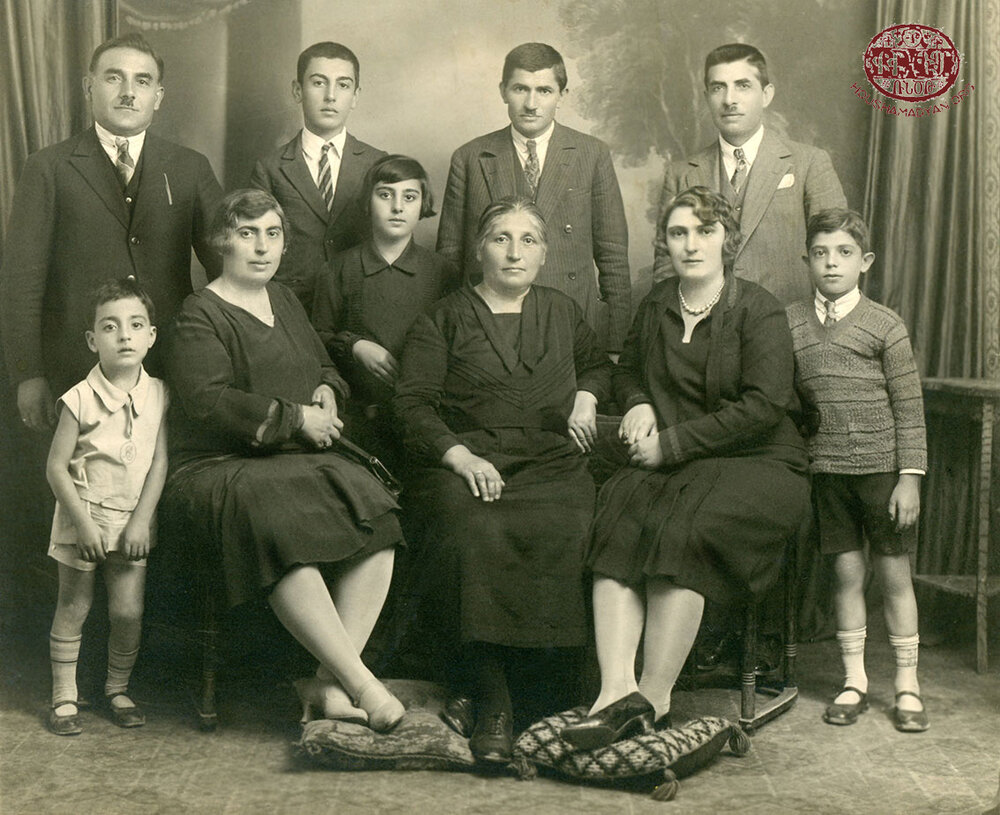
Garabed (aka Garbis) Karekin Ayanian (born in Ottoman Empire, Banderma in 1914—died in USA, Philadelphia in 1991) was born when there was news of war. His father was Karekin Ayanian, and his mother was Hripsimé (née Taniel Allahverdian) Karekin Ayanian, they took him to Constanța and soon after, Romania entered in World War I on the side of the Allies in August 1916. So, parents and baby Garabed fled and sheltered in Odessa, Russia. His sister, Hermine, was born in Odessa at the end of the war.
After the Armistice in 1918, the Ayanian family went to Constantinople because Hripsimé’s siblings, Nevart and Kevork Allahverdian were resettling there. However, when Kemal Mustafa Kemal Atatürk became the president of the Republic of Turkey in 1923, they returned to Constanța. Garabed attended a primary Armenian school in Constanța and then he attended a public high school. In 1923, Garabed had a brother; they called him Serko.
In 1943, Garabed’s sister, Hermine, married Hagop Djirikian and his father, Karekin Ayanian, died in 1947. Later, Garabed relocated his mother, Hripsimé, and brother, Serko, to Bucharest.
On December 18, 1947, Garabed married Haiganoush (née Nevshehirlian) Garabed Ayanian (born on a ship on route to Romania on January 15, 1922—died in USA, Philadelphia on December 28, 2018).
Haiganoush was the daughter of Stepan and Dikranouhi Nevshehirlian of Kayseri. Her siblings were Manoush, Ardemis, Angel, Zarouhi and Kevork. Surviving the Genocide, their parents rebuilt their lives in Romania; Stepan was a successful merchant in Bucharest. Prior to her marriage, Haiganoush’s sister Zarouhi died from childbirth complications in 1941. Consequently, she and her mother shared the responsibility of raising that child.
Romania became a satellite of the Soviet Socialist Republic (SSR) on December 30, 1947. Properties and wealth were confiscated. Many people were jailed for hiding family material wealth or gold, once even Haiganoush went to prison. Instead of private businesses and stores, the government established cooperatives and men and women labored in industries. For a while, Garabed worked in a factory in Bucharest.
Haiganoush and Garabed had a son:
- Karekin Garabed Ayanian (born in Romania, Constanța, on 1949)
The Ayanians—Garabed Ayanian, his wife Haiganoush and son Karekin and grandmother Hripsimé—obtained their visa for Lebanon and departed by ship from Constanța. Traveling with them was his brother Serko Ayanian, his wife and three daughters, his sister Hermine Djirikian, her husband Hagop and son Ara, as well as Hagop Ashekian, his wife Ovsanna, his son Pakrat and Vahram Iynedjian, Ovsanna’s brother. These families were the descendants of Haji Harutiun Iynedjian from Kayseri (See POST II): Hagop Parsegh Ashekian was the son of Diruhi (née Haji Harutiun Iynedjian) Parsegh Ashekian; Hripsimé’s mother was Nevrig (née Haji Harutiun Iynedjian) Taniel Allahverdian, and the father of Vahram and Ovsanna was Hovhannes Haji Harutiun Iynedjian.
The group arrived in Beirut Port in the autumn of 1959. Haiguhi (née Parsegh Ashekian) Sarkis Bakalian, Hagop’s sister, had relocated from her apartment in Khandaq el-Ghamiq to her son’s home in Badaro, in a new neighborhood. The flat of Khandaq el-Ghamiq had a large living room, surrounded with five rooms: and a kitchen, a toilet/bath, an attic and a roof to dry laundry. The space was cramped, but it was free and the location excellent. While waiting for their visa for the U.S.A., this group occupied this space, with help from the American National Committee to Aid Homeless Armenians (ANCHA) until they acquired their immigration papers to the U.S.A. In the meanwhile, the adults found jobs, and Ara and Karekin attended Djemaran of Hamazkayin.
The Ayanian and Djirikian families settled in Philadelphia on June 30, 1961 and Hagop Ashekian’s group went to Los Angeles. Rev. Arsen Hagopian of Saint Gregory Armenian Apostolic Church (on Ridge Avenue, Philadelphia) hired Haiganoush as a seamstress and Garabed found work and Karekin went to school. Time passed, the Ayanians bought a house and paid for Karekin’s college, who studied chemistry. As more relatives and friends arrived from Romania, they settled in Upper Darby/West of Philadelphia and they established a community living within a block from each other.
Haiganoush and Garabed were thrilled when their son Karekin got married to Ardemiss (née Nazret Nazarian) Karekin Ayanian in 1972. Ardemiss was born in Palestine/Israel and emigrated to the U.S.A. with her parents Nazareth and Ankine and sisters in the early 1960s.
Karekin taught chemistry, owned a dry cleaning business, ultimately opened his own business in 1994, “Mediterranean Foods”, located
in Upper Darby, PA. He makes soujouk, and lahmajoun from scratch; they are known as the best in the eastern United States. Karekin makes
deliveries himself to Philadelphia, Washington, D.C. and New Jersey and ships to other places. Ardemiss’s parents and Karekin’s mother helped him until they were physically able, and wife and children still work alongside him.
Karekin and Ardemis had three children:
- Garo Ayanian (born in the USA, Philadelphia in 1979) studied commerce and engineering at Drexel University. He married Stephanie (née Garoian) [23] and they have two daughters.
- Lorig (née Ayanian) Antranig Baronian (born in the USA, Philadelphia in 1981) studied mechanical engineering at Drexel University. The couple have three daughters.
- Nora (née Ayanian) Edwin Zargarian (born in the USA, Philadelphia in 1982) got a Doctoral degree in mechanical engineering from University of Pennsylvania and works in academia.
The couple have two sons.
Garabed died in Philadelphia in 1991 from a heart attack.
Haiganoush lived in her house until she was about 90 years; then her last years were in the care of her son and daughter-in-law in their house. She also witnessed her six great-grandchildren.
Hermine (née Karekin Ayanian) Hagop Djirikian (born in Russia, Odessa on May 12, 1918—died in USA, Knoxville/TN on February 12, 2014) attended Armenian schools in Constanța, and later she attended a seamstress school. Young women like Hermine at that time would learn cooking, baking, embroidery, knitting, and many skills needed as a wife and mother.
Hermine married Hagop Djirikian (born in Ottoman Empire, September 6, 1909—died in USA, Knoxville/TN, on September 4, 1981) on December 18, 1943. He was a native of Kotyaio/Kütahya. In the Ottoman Empire, Armenians settled there and dominated tile-making and ceramic production. Hagop survived the Genocide and settled in Bucharest. He had learned to use leather to make fine handbags, purses, as well as wallets and pouches.
Hermine and Hagop had a son:
- Ara Hagop Djirikian (born Romania, Bucharest, August 1, 1945—died in USA, Knoxville/TN, on June 20, 2017)
When Hermine’s brother, Garabed Ayanian, and family were going to emigrate, she and her husband Hagop and son Ara also got visas to Lebanon. The Djirikian arrived in Beirut in late 1959. They lived in the apartment of Khandaq el-Ghamiq, close to downtown. It was difficult to be equivalent among the couples, adult men, and children and grandmother. Hermine chose to give a bigger room for her elder brother; she and her husband and son took the attic. [24] Ara attended Djemaran of Hamazkayin and Hermine worked with a seamstress and Hagop found a job sewing leather handbags at an Armenian business. Hermine and her cousin, Sona (née Kevork Allahverdi) Pakrat Bakalian, had met as children; in Beirut they reconnected as adults and became close until their deaths.
When the immigration documents were ready, they arrived in Philadelphia on June 30, 1961. Hermine ran a dry cleaning and alteration shop in the front of their home, while the family lived in the back. Hagop worked for an Armenian entrepreneur.
Ara Djirikian attended high school until he joined the U.S. Army in 1963. He was stationed in Germany and worked on tanks. Unfortunately, he was severely injured in a car accident with two other servicemen on an icy evening. His two friends died, and he injured his two legs. He was air-evacuated to Walter Reed Medical Center in Washington, DC. The surgeons amputated his left leg due to severe damage and replaced it with an artificial one. He stayed at Walter Reed for a total of two-and-a-half-years for rehabilitation. His parents who lived in Philadelphia visited him once every few months.
Ara met his wife, Nancy Brentalynn Moore, during his time at Walter Reed at a pizza parlor in 1966. She was training to be a nurse; she was from Lexington, Kentucky. In 1968 they married in Washington, DC. She got her practiced nursing degree, and he graduated from the Catholic University of America in electronic engineering in 1973.
In 1974, the Djirikian family relocated to Knoxville, TN, including Hermine, Hagop and grandmother Hripsimé. Ara worked as an Electrical and Nuclear Engineer primarily on Sequoyah Nuclear Power Plant in Hollywood, Alabama. He also worked in Watts Bar Nuclear Power Plant. Ara was responsible for all the electronic of nuclear plants located on the Tennessee River. However, after the Three Mile Island Nuclear Generating Station (TMI) accident in 1979, the government stopped its nuclear plants, and Ara was the only employee.
Ara and Nancy had two sons:
- David Djirikian (born in USA, Washington, DC, in 1972)studied law and works in insurance. He is married to Theresa (née Talbott).
- Daren Djirikian (born in USA, Knoxville, TN, in 1974)graduated from University of Delaware in Biochemistry and Public Health.
When Ara retired, he designed the blueprints of his house himself for a person with a disability. He oversaw the builders to end it in nine months. Ara enjoyed cars and driving. He took his family to Germany, France, Italy and other parts of Europe.
Hermine started employment at Penny’s West Town in the alterations department in 1976 until 1984, when she retired and lived in a senior housing. She doted her grandsons, David and Daren. She often traveled, visited Montecatini Terme (north of Florence) for its healing waters and natural hot spring; she visited the Armenian Republic and while in Yerevan, she met her cousins, Taniel and Stepan Allahverdian and their families. Just before she died, she had lost her memory and could not identify even her only son.
Serko Karekin Ayanian (born in Romania, Constanța on December 15, 1923—died in USA, Jamaica, NYC, on May 26, 2019) received his education in local schools. He was a self-employed electronic and television specialist in Bucharest.
Serko Ayanian married Arus (née Boudoughian) Ayanian (born in Bucharest, Romania on July 26, 1928—died USA, in Queens, NYC on September 4, 2019) in Bucharest in 1949. Her father Karnig Budughian was a shoemaker in Gallipoli/Gelibolu [north of the Dardanelles/Çanakkale Boğazı].
The couple had three daughters:
- Mary (née Ayanian) Avedis Boyadjian (born in Romania, Bucharest, in 1948) studied computers.
- Louisa Ayanian (born in Romania, Bucharest in 1952) studied business and works in insurance claims in New York.
- Loretta Ayanian (born in Romania, Bucharest in 1954) after her college in the USA in New York, she went to Romania and got her M.D. She is a psychiatrist and practices in New York City.
When the Ayanian and Djirikian families arrived in Lebanon in late 1959, they all stayed in the apartment on the third floor in Khandaq el-Ghamiq. Serko with his wife Arus and three daughters lived in this cramped accommodation for two months. Next, he rented an apartment in Dora (north of Bourj Hammoud), their landlord was an Armenian, in the military and his wife was Lebanese. Serko Ayanian worked for Boulos Freres & Co., an exclusive distributor of German GRUNDIG consumer electronics products and he learned to repair televisions.
In 1961, Serko Ayanian and family came to the USA, settling first in Philadelphia, he worked in a bread factory. Through the help of an acquaintance, he moved to New York City and serviced air conditions in Saint Regis Hotel and The Carlyle Hotel and hospitals. Serko and Arus supported their daughters to finish high school and college.
Later Serko Ayanian had his own business in Queens, NY. He loved soccer and took his daughters to see all the Armenian games in New York and New Jersey.
In 1973, Mary married Avedis Boyadjian (born in Romania, on May 3, 1930—died in New Jersey, on September 22, 2019). Their honeymoon was in Switzerland, Lebanon, Romania and two days in Vienna.
The couple had two sons:
- Avedis Jr. Boyadjian (born in 1975 in USA, New Jersey) studied pharmaceuticals.
- Ara Boyadjian (born in 1976 in USA, New Jersey) studied Chemical engineering.

The Fifth Generation
Descendants of Harutiun and Elena Allahverdian
Taniel Harutiun Allahverdian (born in Romania, Constanța in 1927—no data) attended Armenian schools in Romania; when his father wanted to repatriate to Armenia in 1947, he went with his parents. In Yerevan, he was a watchmaker. He married Arshaluys, an Armenian who repatriated from Romania as well. He had a house in Nor Arapgir (a neighborhood in Yerevan).
The couple had a son and two daughters:
- Harutiun Taniel Allahverdian (born in Yerevan in 1952—no data)
- Hripsimé Taniel Allahverdian (born in Armenia, Yerevan in 1955—no data)
- Haiguhi Taniel Allahverdian (born in Armenia, Yerevan in 1960—no data)
Stepan Harutiun Allahverdian (born in Romania, Constanța in 1931—no data) attended Armenian schools in Romania; when his father wanted to repatriate to Armenia in 1947, he went with his parents to Yerevan. In the 1960s, he worked as the supervisor of a restaurant run by the state. He met Seta in Yerevan and married her. They lived in a house in Nor Arapgir.
They had two sons:
- Kevork Stepan Allahverdian (born in Armenia, Yerevan in 1955— no data)
- Karekin Stepan Allahverdian (born in Armenia, Yerevan in 1957—no data)
Sona (née Allahverdi) Bakalian traveled to Armenia SSR in 1981 with a church group from Lebanon. During this opportunity, she visited her cousins Taniel and Stepan. A few years later, Hermine Djirikian also visited her cousins while in Yerevan.
Until her death in 2006, Sona corresponded on the phone with the daughter of Taniel Allahverdian, Hripsimé, who had moved to Los Angeles.
The Fifth Generation
Descendants of Haigazun and Marie Suzmeyan
Berdj/Berdje Haigazun Suzmeyan (born in Romania, Constanța on September 15, 1918—died in USA, in Los Angeles, October 21, 2000) his mother was Marie (née Hovhannes Iynedjian), and her grandfather was Haji Harutiun Iynedjian from Kayseri. Berdj attended a German boarding school in Romania. Then he became a designer for engineering projects.
Once Romania became a satellite of the Soviet Socialist Republic (SSR) in 1948, the population’s houses, prosperities and even jewelry were confiscated. Berdj’s father was lucky that he was a subject of Iran; with his parents, and brothers, Hagop and Levon he left Romania and went to Lebanon in 1951. The three brothers were in their twenties when they were in Beirut; each of them found appropriate jobs. When Levon decided to immigrate to the United States, he took his parents with him. Berdj and Hagop also settled in Los Angeles.
Berdj found a position with an Armenian engineer by the name of Baghdasaryan as a designer.
Berdj married Nargiz (née Papazian) Berdj Suzmeyan (born on October 3, 1926—died in USA, Los Angles, October 2, 1998) she was from Aleppo. This couple had a son:
- Shahan Berdj Suzmeyan (born in USA, Los Angeles, 1964) lives in California.
Hagop/Jacob Haigazun Suzmeyan (born in Romania, Bucharest, on September 20, 1925—died in USA, Los Angeles on August 2, 2010) attended a German boarding school like his brother in Romania. When Romania became a Socialist Republic, life became miserable. The Suzmeyan family went to Lebanon because his father had an Iranian passport.
Hagop worked in a German airplane company in Beirut; that company also had branches in New York, so Hagop immigrated to the United States
In April 1968, Hagop went to Greece on vacation. There, he met Meliné, she was the sister of Shushan (née Sarkis Stanbulian)Ohaness-Pakrat Ashekian and liked her.
Hagop Suzmeyan married Meliné (née Sarkis Stanbulian) Hagop Suzmeyan (born in Greece, July 23, 1938—died in USA, Los Angeles on May 11, 2002). Meliné’s father, Sarkis Stanbulian, was originally from Kayseri and her mother was Eliza(née Lafdjian); her brother was Hagop Lafdjian/Aida Ashekian’s ex-husband.
When Meliné’s documents for her immigration to the Unites States of America arrived, she settled in Los Angeles with her husband Hagop, at that time, he was working in a bank circa early 1970s.
Levon/Leo/Leofet Haigazun Suzmeyan (born in Switzerland on December 30, 1926—died in USA, Los Angeles on September 2, 2004) like his brothers attended a German boarding school in Bucharest. After 1948, conditions in Romania became more and more atrocious; his father had an Iranian passport, so he took his family to Lebanon in 1951.
In Beirut, Levon repaired cars. His employer sent him to Germany to specialize in their cars and when he returned, he worked on new engines.
An Armenian friend in Beirut introduced Levon to a woman and encouraged him to marry her before leaving to the U.S.A. Abruptly he married this Armenian woman and joined his family in Los Angeles and his wife was to follow him later. After some time, Levon’s wife arrived in Los Angeles, but she lived only with him for a week. It turned out that she had a sister who was already living in the U.S.A. The two sisters conspired this scheme to expedite her arrival to the U.S.A., and furthermore she had a husband waiting for her. The two sisters took advantage of Levon’s kindness.
After his divorce, he fell in love of an Arabic-speaker Armenian Catholic woman from Mardin, Turkey. He wanted to marry her, but she wanted to be near her family in Montreal.
While Levon was not successful in his personal life, he was exceptional in his business, he bought a gas station and a repair shop.

The Fifth Generation
Descendants of Garabed and Berjouhi Ashekian
Aida-Zaruhi Garabed Ashekian (born in Romania, Constanța on November 13, 1927—died in USA, Southern California on April 24, 2001). Her home included her twin brother Baruir and her older brother, Parsegh who was drowned at the age of eight in 1931, her parents, Garabed and Berjouhi, her grandmother Diruhi and uncle Hagop Ashekian. She spoke with her parents in Armenian and learned Turkish from her grandmother; at school they learned Romanian and then French and English later. In summer 1937, her aunt, Haiguhi, with her daughter Mampile and son Vasken and her aunt Marine’s daughter Chaké, visited them. Haiguhi’s husband had died the past summer; she needed a change. When they returned to Beirut, Diruhi went with them.
Aida received her primary and lyceum/high school at the public schools of Constanța and was then admitted to the pharmaceutical faculty of the University of Bucharest; however, she did not complete her education due to an illness. In 1948, Romania became a Socialist Republic and life was miserable for them. Haiguhi’s sons had acquired Lebanese passports for Garabed Ashekian’s family. They left from Constanța by a ship in May 1951 and arrived the Port of Beirut in June. The nephews found an apartment for them in Mar Mikael, a neighborhood not far from the souks/markets. Haiguhi paid Aida’s tuition to attend the Faculte de Pharmacie à Université Saint-Joseph de Beyrouth. In 1954, she received the Diplôme Français de Pharmacien; and then she worked in the university’s laboratory until 1958 when she submitted her resignation and joined her brother in Canada.
Aida married Hagop Lafdjian who was born in Istanbul and employed as a physicist in Evanston (IL) in the United States. The wedding took place at St. Gregory the Illuminator Church in Sainte-Catherine (southwestern Quebec) and Very Rev. Fr. Vasken Tatoyan officiated the service, January 1959.
Shortly after, Hagop Lafdjian moved to El Monte (CA), where there was a branch of the same company and his wife relocated to the United States. Aida had already attended pharmacy schools in Bucharest in Romanian, in Beirut in the French language and in California in English. She attended courses at University of California, Los Angeles, to validate her pharmacy degree. On June 1961, Aida finally obtained her B.S. degree and a license to practice pharmacy in California.
Aida’s husband left his company and found a new job in Santa Ana and they purchased a house in that neighborhood. She worked at a pharmacy in the area. The owner of a drugstore did not have a certificate, so the pharmacy was run under her name.
Aida divorced Hagop Lafdjian in 1970 and kept civil relationships with him and maintained properties they bought together. She loved opera and tried to attend as often she could, sometimes she went with friends to San Francesco Opera. She took her nieces Hilda and Anahid to Europe and was close to his brother Baruir, sister-in-law Angel and their children.
When Aida retired, she sold her house in Santa Ana and moved to a condo in Dana Point (still in Orange Country). Her guests enjoyed the view and would walk along the Pacific Ocean.
Baruir-Baghdasar Garabed Ashekian (born in Romania, Constanța on November 13, 1927—died in Canada, Ottawa in 2006) like his twin Aida received his elementary education at the local public school in Constanța. Then Baruir attended the University of Bucharest and in 1951 graduated as an airplane engineer and immediately Transylvania Airlines/Transavia offered him a job, but he turned them down.
In Lebanon, Baruir found a job with Middle East Airline as an inspector, first he worked in the old airport at Bir Hassan Airfield too close to the city center. In 1954 a larger and modern airport, Beirut Airport, was built, along the Mediterranean and south of the city; Baruir went to London for three months to specialize on their planes and followed courses in strategic planning. When he returned to Beirut, he was appointed branch chief.
After living in Lebanon for six years, Baruir had no confidence in Lebanon’s future; he left in 1957. When a civil war happened between Muslim and Christian Lebanese in 1958, and later the Civil War (1975-1990), his pessimism was affirmed. His sister Aida left Lebanon in 1958 and he invited his parents to immigrate to Canada in 1959.
Without a Canadian citizenship, Baruir had many challenges; still he contacted Canadian acquaintances to see if he could join Air Canada; and tried a company in Ontario, but their products did not sell well. Consequently, he found a job as an inspector at the Airport of Saint-Jean-sur-Richelieu, Quebec, southwest of Montreal. He also rented a house in Iberville, a room for his parents and another for him; it was about 15 minutes from the airport.
The Airport of Saint-Jean-sur-Richelieu needed airplanes designed to extinguish forest fires. Baruir prepared the design, fixed two water containers under the wings of a plane and tested it successfully.
On December 17, 1960, in Saint John the Evangelical Church in Montreal, Baruir married Angel (née Bedirian) Ashekian (born in Syria, Aleppo, in March 1935). There were very few Armenians in Montreal in circa 1958 and those who were there gathered together for events and Baruir and Angel had mutual Armenian acquaintances.
Angel’s father was Sarkis Bedirian (born in Ayntab—died in Quebec circa 1959) and her mother was Meroum (née Kouzoukian/born in Ayntab—died in Quebec circa 1964). Sarkis’s business was in dyeing fabric. The couple had four daughters and two sons:
- Loucine (born in 1914—died in 1990
- Yeranik (née Bedirian Antoine Aysseh born in 1915—died in 2002) [25]
- Noubar (born in 1918-died in 2007)
- Juliette (née Bedirian) Angelo Bartolini (born in 1922—died in 1998)
- Albert (born in 1928)
- Angel (née Bedirian) Ashekian (born in 1935)
During the Genocide, the Bedirian family left their house and prosperities and walked to Aleppo where their last two offspring were born. In 1942, the family went to Teheran because Yeranik (née Bedirian) Antoine Aysseh lived there; her husband owned a car dealership. Angel, who was 20 years younger than her sister Yeranik, grew up with her nephews and nieces and attended an American school. Then Angel went to a college in North Carolina; but she did not complete her course and instead joined her siblings in Montreal circa 1958. Her sister Juliette Bartolini with two children was living in Montreal and her brother, Albert Bedirian, was a student in agriculture at the MacDonald campus of McGill University and when he finished his degree, he bought a farm in St-Hyacinthe, Québec. Also, their parents left Iran and lived in the farm. They had a beautiful garden, Albert grew vegetables, flowers and fruit trees.
Baruir befriended Noubar and Albert and got along very well with both of them until their death. Noubar would watch his mother as a child in the kitchen and became a great cook, he and his sister Loucine were also the chronicler of the Bedirian family. Albert and Baruir were closer in age and loved the outdoors and went camping and canoeing, enjoying natural sites of Quebec and would do expeditions in fishing.
Angel and Baruir had two daughters and three sons:
- Hilda-Aida (née Ashekian) Philippe Florentin (born in Canada, Saint John's/Quebec in June in 1962) has three daughters and manages holiday cottages in Hatley, Quebec.
- Anahid-Miranda(née Ashekian) Alec Gulesserian (born in Canada, Montreal in April 1964) lives in San Jose (CA) and adopted a girl and boy from Armenia.
- Haig-Garabed Ashekian (born in Canada, Sherbrooke, QC, in 1965) practices medicine in Canada, Ottawa. He is married to Hermineh (née Ohanian) and has two daughters.
- Ara-Sarkis Ashekian (born in Canada, Sherbrooke, QC, in 1965) specializes in bridges. He is married, has a daughter and a son and lives in Vancouver.
- Dikran-Jirayr Ashekian (born in Canada, Sherbrooke, QC, in March 1968) is an engineer, and lives in Montreal.
After attending evening classes for one full year and day classes the next, Baruir graduated with a Master’s in Mechanical Engineering from McGill University on October 5, 1962. Also, about this time, Baruir got his Canadian citizenship. He was working in Montreal and bought a house in the suburbs—Pierrefonds-Roxboro. And Angel received her college degree in elementary school education on June 1, 1962.
In 1964, Université de Sherbrooke, QC, needed a professor of mechanical engineering, they contacted McGill University and the specialists recommended Baruir. He found the pay decent and the future promising, he accepted the offer. During the first year, Baruir commuted between Montreal and Sherbrooke; on Mondays he went to work and came home on Friday evenings. The second year, Baruir rented a house and Angel and the children, and his parents moved in Sherbrooke. His brother-in-law, Albert sold their farm, as his mother had died, and he bought the house of the Ashekians in Pierrefonds-Roxboro. After 1965, Angel taught substitute teaching and taught French at the Lennoxville high school in Sherbrooke.
Baruir’s cousin Sirarpie (née Ashekian) Yaghdjian sent an invitation for her son Vicken’s wedding; Baruir, Angele, daughter Anahid, son Haig and wife attended the ceremony in New Jersey on November 28, 2004. It was the last time that the Fifth Generation of Ashekian Clan from Kayseri saw each other. Baruir had cancer and passed within three years.
When Baruir died in 2006, Angel continued living in their home. Then the following year, in 2007, her older brother Noubar passed away; her brother Albert sold the Pierrefonds house and moved to a duplex apartment with his sister Angel. In 2016, the youngest offsprings of the Bedirians, Albert and Angel, went to a retirement home in Ottawa.

The Fifth Generation
Descendants of Hagop and Ovsanna Ashekian
Ohaness-Pakrat Hagop/Akop Ashikian {they spell their name differently} (born in Romania, Constanța on February 25, 1930—died in USA, Los Angeles on August 29, 1996) received his education in an Armenian primary school and then, he attended a German high school in Bucharest. After 1948, the communist regime of Romania confiscated all private resources. Pakrat worked in cooperatives in Bucharest until he and his family arrived in Lebanon in 1951.
Pakrat found a good job with Malifer Corporation (owned by the Malikian family) in Beirut. There he learned about washing machines, refrigerators, ovens and stoves and electronic heaters. Soon, he mastered the secrets of the trade.
When Pakrat arrived in Los Angeles, he worked for an Armenian who had a repair service. Eventually, he started his own business. Pakrat Ashekian married Shushan (née Sarkis Stanbulian) Ohaness-Pakrat Ashikian (born in Greece, Athens on November 11, 1933—died in USA, Los Angeles in 1990) on September 1, 1964.
Shushan’s father was originally from Kayseri and settled in Greece after the Genocide; her mother was the sister of Hagop Lafdjian, Aida Ashekian’s ex-husband. In October 1964, Pakrat went to Greece to bring Shushan to Los Angeles.
Pakrat and Shushan had two sons:
- Haig-Parsegh Ashikian (born in USA, Los Angeles in 1966)Haig studied law, got his JD and practices in LA. He is married to Marcela (née Hamparsumian) and has two sons.
- Sarkis-Harutiun Ashikian (born in USA, Los Angeles in 1968) studied business and works in Finance.
The two brothers lived with their parents, grandparents, and grandmother’s brother, Vahram. They attended Holy Martyrs Ferrahian High School, not far from their home on Moorpark Street, in Encino.

- [1] Hratch Zadoian, 2012, Our Brothers’ Keepers: The American National Committee to Aid Homeless Armenians (ANCHA) –A Partial History. New York: Armenian Apostolic Church of America- SIS Publications.
- [2] Mardikian (1903-1977) was born in Bayburt, Ottoman Empire (about 140 km south of Trabzon, Black Sea) educated in Scutari, Constantinople. His father was an intellectual arrested on April 24, 1915 and his mother’s brother Krikor Amirian was an Armenian revolutionary and contributed to the first Republic of Armenia (1918-1920). He arrived at Ellis Island in 1922 and went to San Francisco; his job was to be a dishwasher in a café. During World War II, he became a Quartermaster of the U.S. Army and he helped many Armenian Displaced Persons in Europe. He and Suren Saroyan started the ANCHA. He entertained famous people in his Omar Kahayyam restaurant in San Francesco. [Why I close my Restaurant: A “This I Believe” Essay, George Mardikian; Jay Allison and Dan Gediman, eds. Macmillan Audio, 2006; www.armeniapedia.org/wiki/George_Mardikian]
- [3] Suren Saroyan (1905-1995) was born in Fresno, a cousin of the writer William Saroyan, and an alumina of Stanford Law School 1929. [https://www.findagrave.com/memorial/156632432/suren-saroyan]
- [4] The 1965 Immigration Act replaced the 1953 Act. During the 12 years, the tens of thousands Armenians from Romania, Bulgaria, Syria, Cyprus, Egypt, Iraq, Armenia SSR, and the Soviet Union, see Zadoian.
- [5] Zadoian, p. 60. Further, he writes, “From 1948 to 1956, the Romanian authorities summarily turned down requests for an exit visa, even for foreign citizens and for Nansen Passport holders, who carried distinctive identity cards and who had to pay a residency tax. Requests for an exit visa were considered a mark of questionable loyalty to the regime. Very few were able to leave the country legally,” p. 62.
- [6] Ibid, p. 60.
- [7] Ibid, p. 63.
- [8] Ibid.
- [9] Zadoian writes that after 1965 there was possible to fly to Beirut (Ibid, p. 63).
- [10] Ibid, p. 64.
- [11] Ibid.
- [12] Ibid., p. 70.
- [13] Ibid.
- [14] Garabed P. Ashekian in The History of Uzun Ashekian writes that Gyuldudu died at the age of 105. Given that Bedrig Bohdjelian witnessed her death in 1957, she should be born in 1854. His calculation makes significant gaps between the births of the Iynedjian sisters. The birth dates in the early 19th century are unreliable; therefore, one has to estimate the age at the death time and not a factual number.
- [15] Constantinople and Smyrna became Istanbul and İzmir after the founding of the Republic of Turkey.
- [16] Garabed P. Ashekian, The History of Uzun Ashekian, Beirut: Donikian Press, 1968, page 17. Translated by Vatche Ghazarian (Monterey, CA, 2013).
- [17] In the 1934 wedding photo of Stepan Allahverdian to Marie Dilsizian, Armenag is still mourning his wife Armenuhi by wearing a black ribbon on his arm.
- [18] Many of the dates of birth and death of Armenians (and probably others) in Anatolia in the 19th century are not accurate. Hripsimé’s birth is June 26, 1891 on her tombstone. However, her youngest sibling, Kevork Allahverdian, was born in 1891, her birth must be circa 1883.
- [19] AGBU Official Repatriation Report, The Hairenik Weekly, September 1, 1949.
- [20] Ashekian, Garabed P. 1968, page 30. The History of Uzun Ashekian. Beirut: Donikian Press. Translated into English by Vatche Ghazarian (Monterey, CA, 2013).
- [21] Garabed P. Ashekian, The History of Uzun Ashekian, Beirut: Donikian Press, 1968, page 77. Translated by Vatche Ghazarian (Monterey, CA, 2013).
- [22] Garabed P. Ashekian, The History of Uzun Ashekian, Beirut: Donikian Press, 1968, page 83. Translated by Vatche Ghazarian (Monterey, CA, 2013).
- [23] Stepahnie (née Garoian) Ayanian is the director and producer of the movie “What Will Become of Us” 2020.
- [24] Ara Djirikian told Anny Bakalian before he died how they lived in Khandaq el-Ghamiq.
- [25] Yeranik (née Bedirian) Antoine Aysseh’s daughter, Linda Chirinian is the author of “Secrets of Cooking: Armenian/Lebanese/Persian” in 1986.
